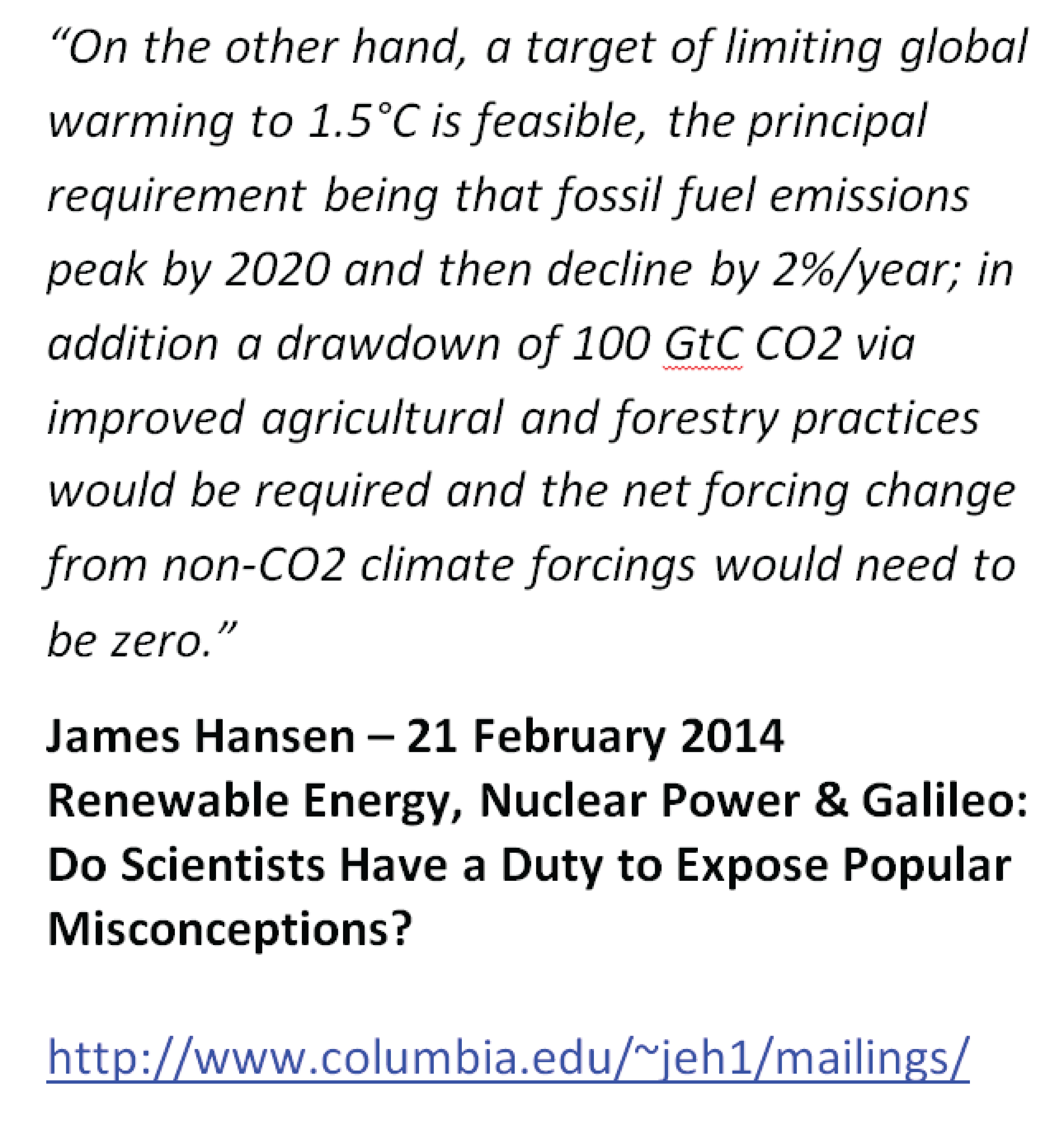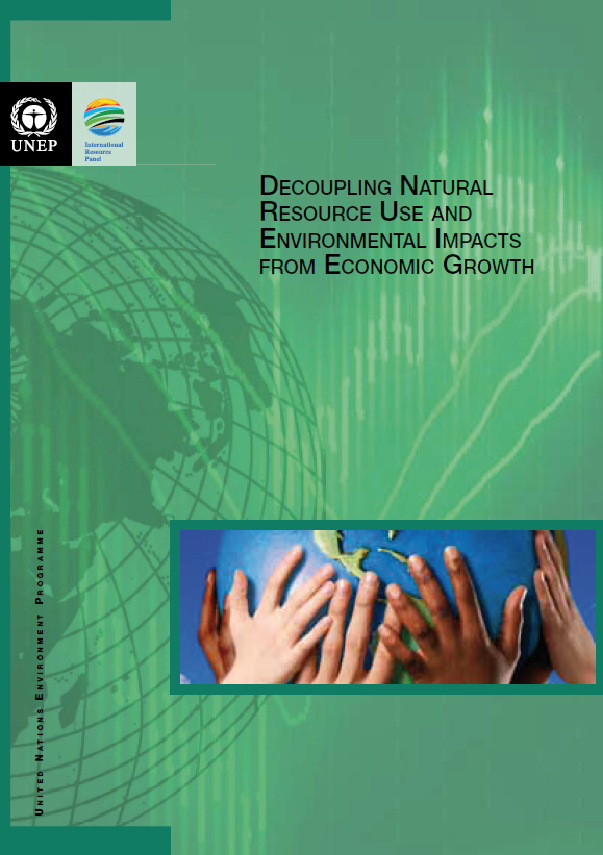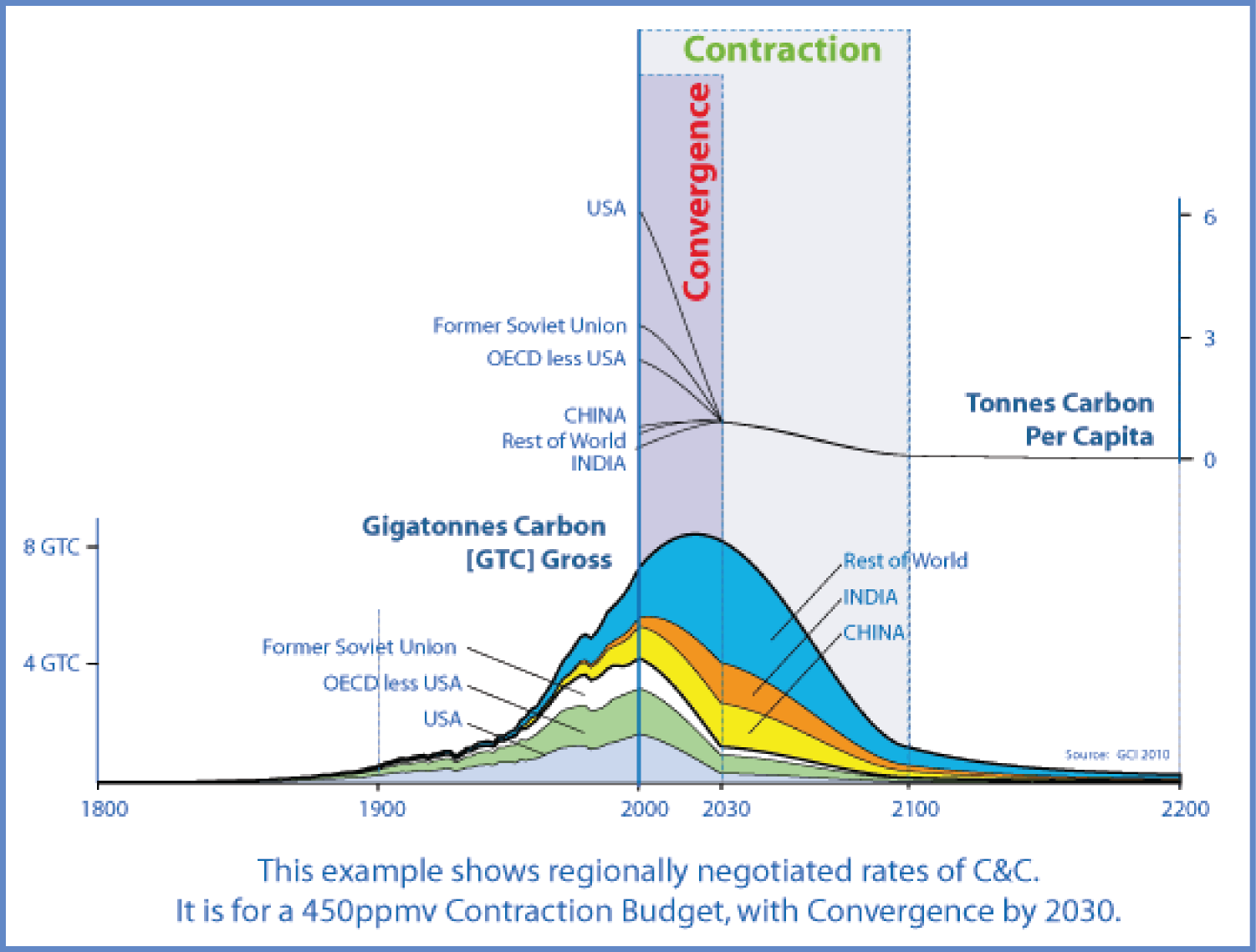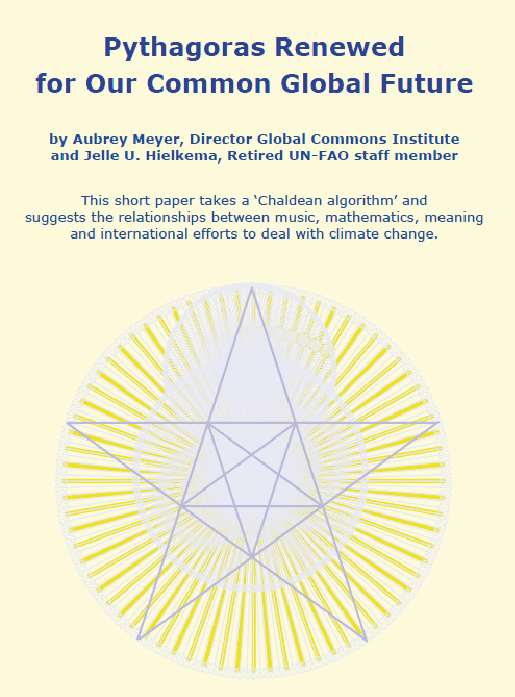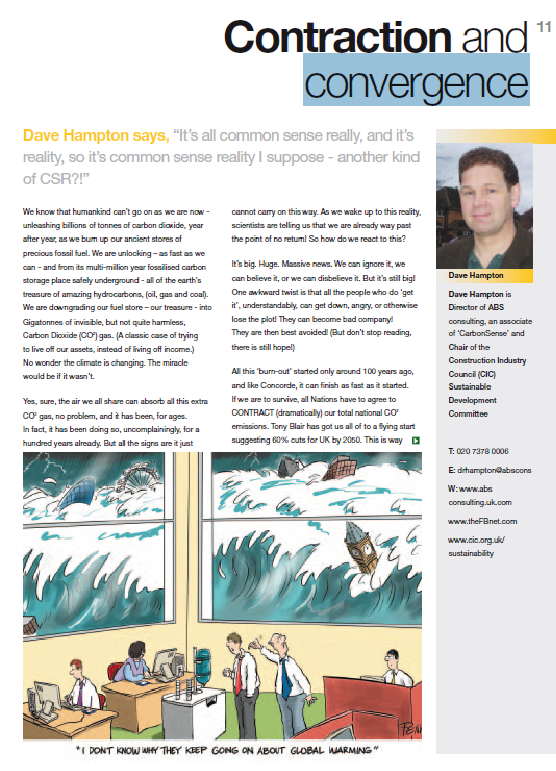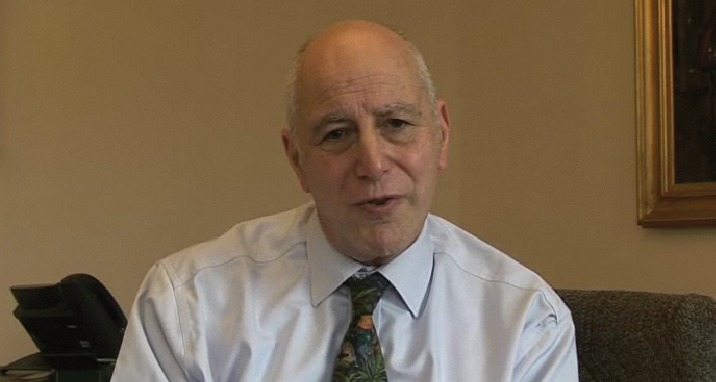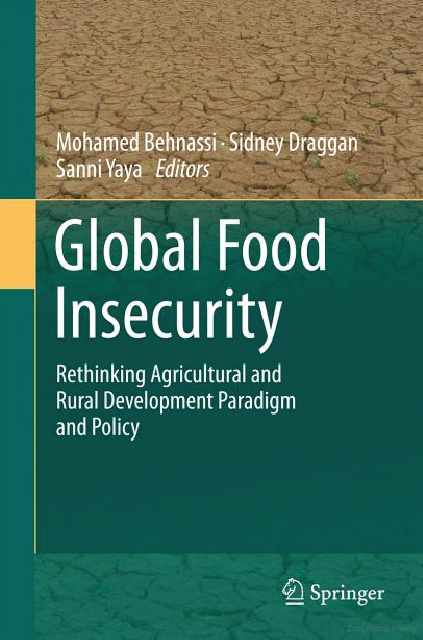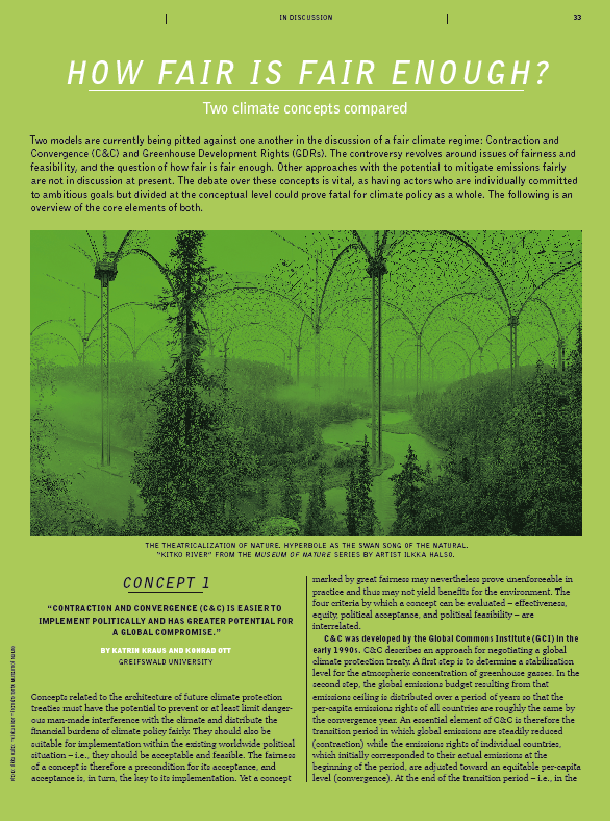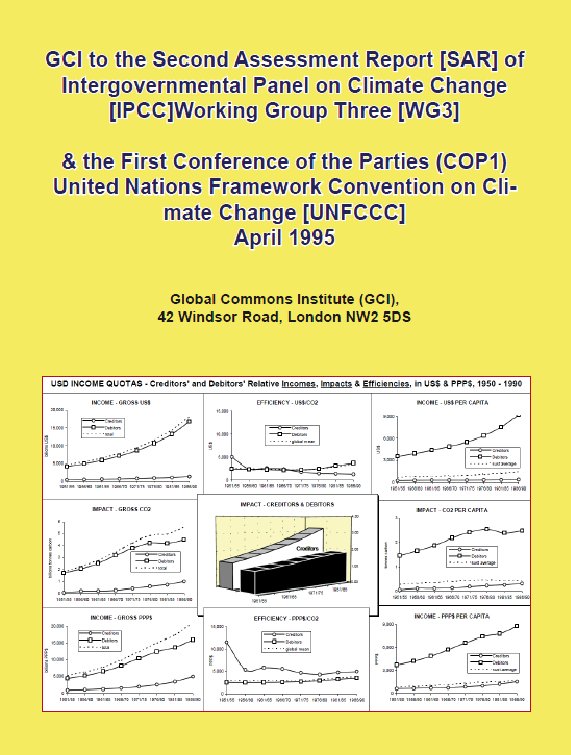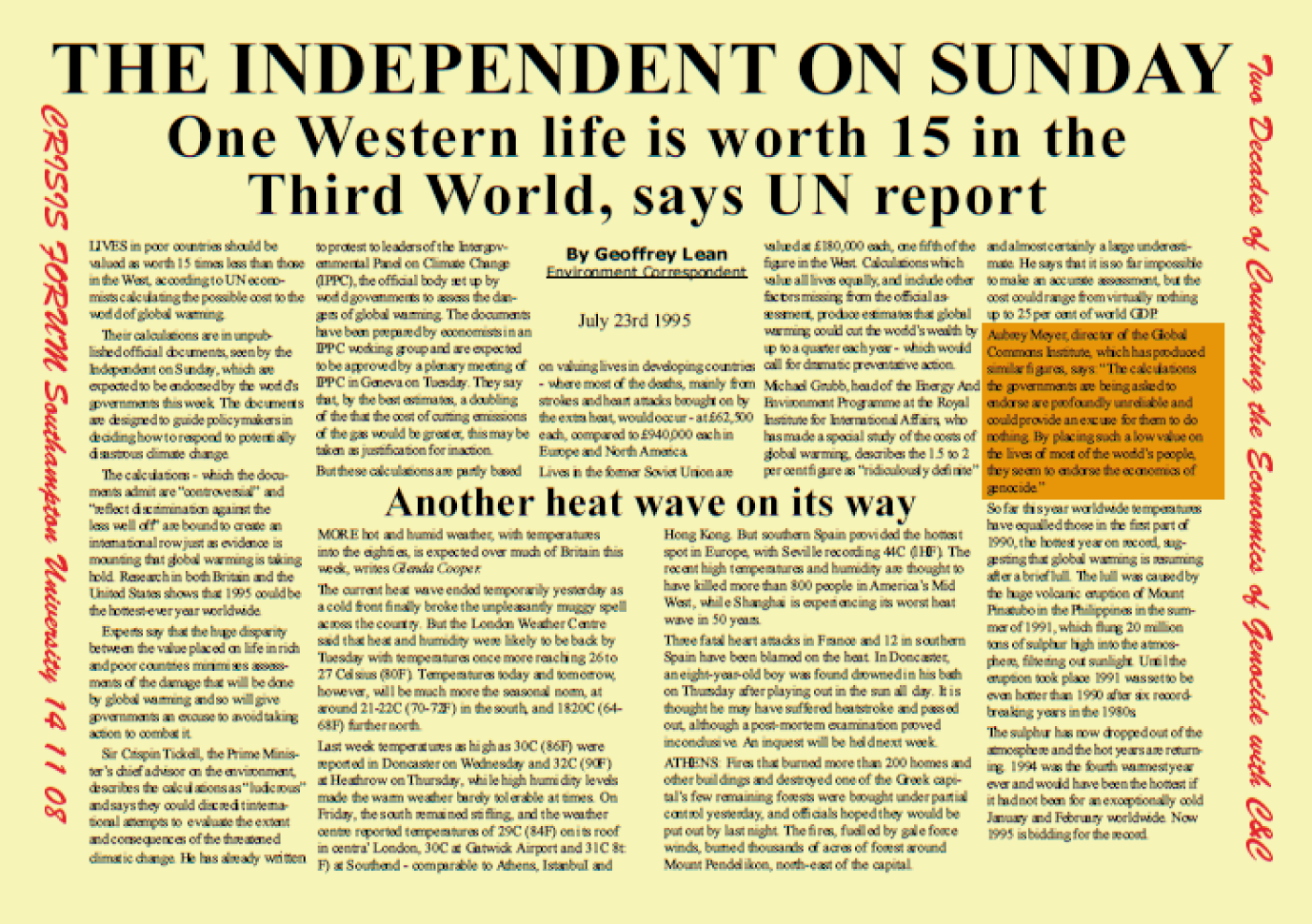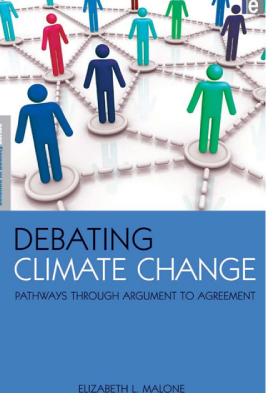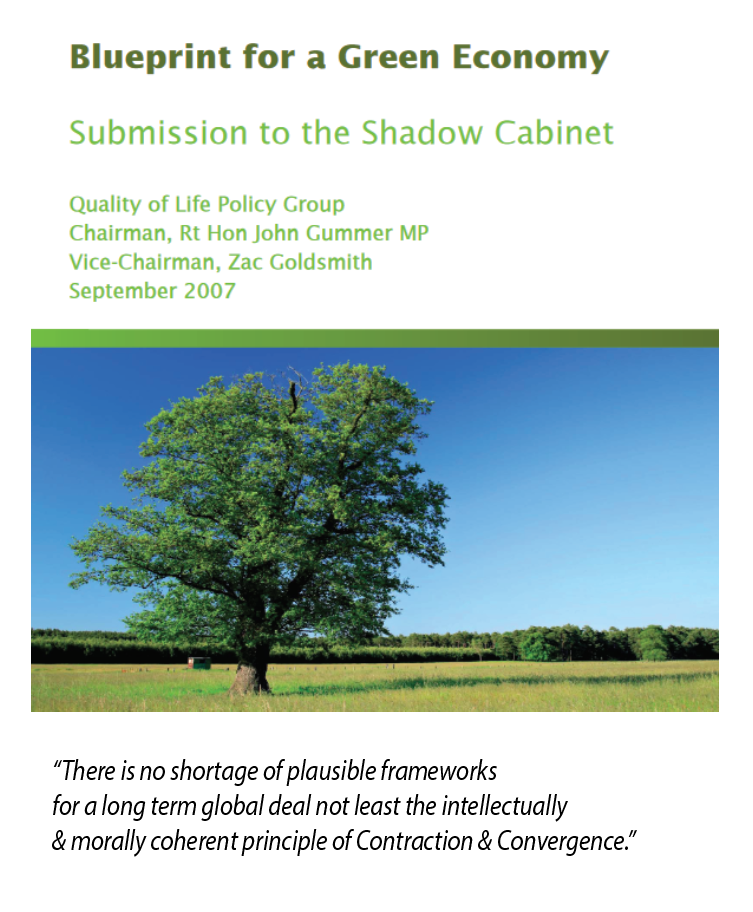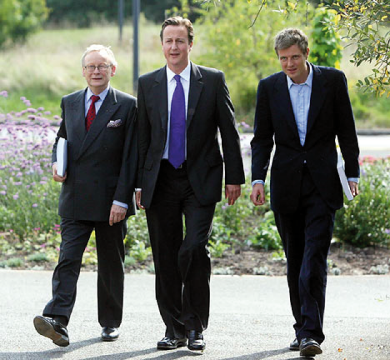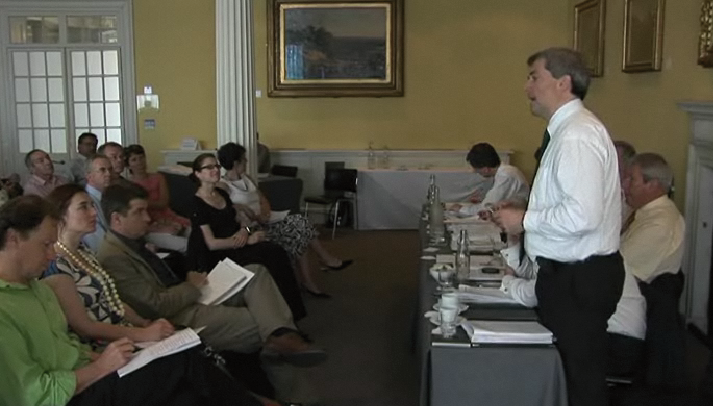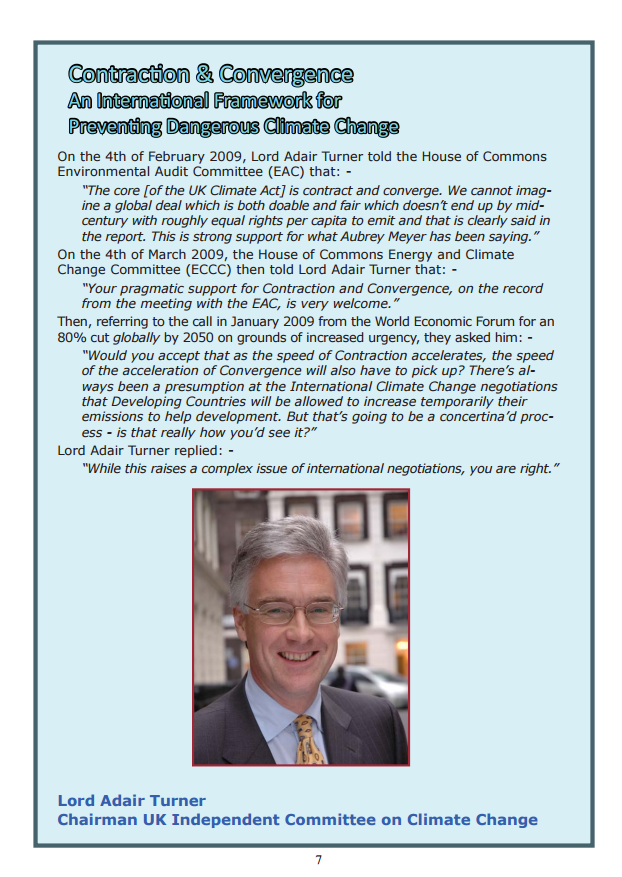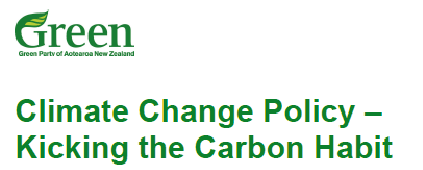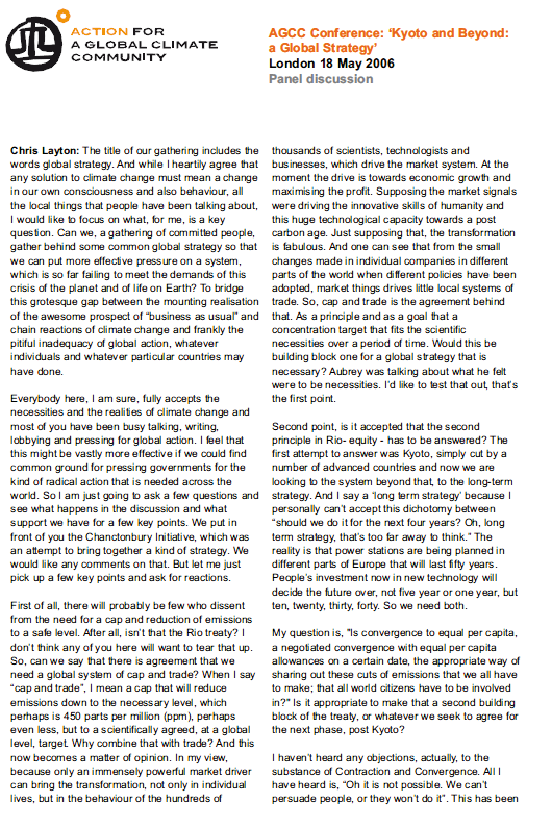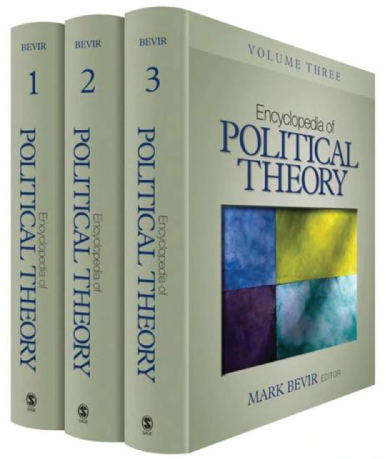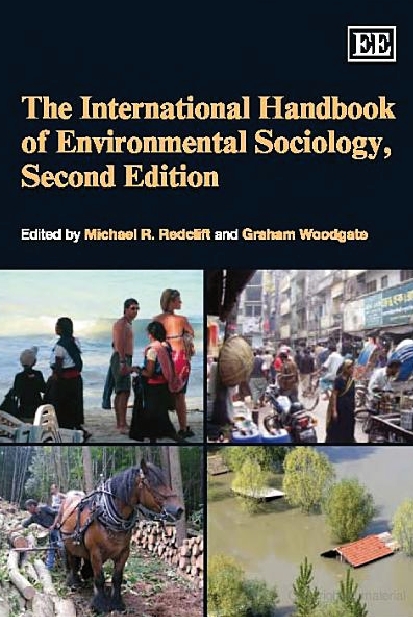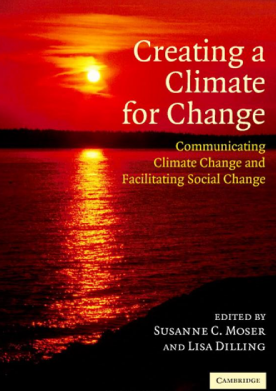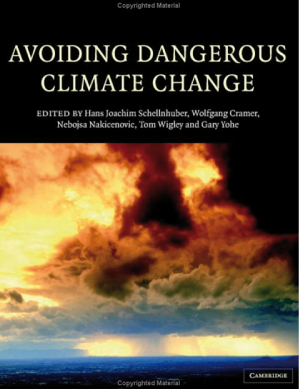Click image below & also here to see a larger pdf file
- Contrarians see concentrations go up while saying temperature goes down.
- UKMO says concentrations go down while temperature goes up - in their model [below] supporting UK Climate Act [UKCA].
- Hansen says a bigger carbon budget than UKCA gets you higher concentrations than UKCA but lower temperature than UKCA [!].
- Feedback effects are omitted from all the above.
- Who do you believe?
- CBAT says work it out for yourself
28 May 2104 - "Meeting the Climate-Science-Policy Challenge [or not]."Introduction - It is understandable that people are: -
- worried about climate change (I certainly am)
- alienated by 'climate-science' (this 'complexity' is something climate scientists perhaps unfairly have taken a drubbing over)
- confused about the 'science-policy' challenges thrown up (most people, especially including 'policy-experts', are).
Science to Policy - Enter the Parts Per Million by Volume [ppmv] and limiting the tonnes carbon emitted (carbon-budgets).
For 20 years safe & stable atmospheric concentrations of greenhouse-gas has been the legally-binding objective of the UNFCCC. The dominant gas is CO2 and this is expressed as an accumulating stock of carbon over time as either Parts Per Million by Volume (ppmv) CO2 or as (Billions of) tonnes of carbon.
The UNFCCC-objective means that 'policy-relevant' climate-science is about restraining the rising atmospheric concentrations of greenhouse gas. As the flow of human fossil fuel emissions largely, but not entirely, drive these concentrations up, reversing that flow through 'carbon-budgeting' is the primary policy issue. These carbon budgets are expressed as a quantified, shrinking flow of tonnes carbon emitted over time.
Policy to Fiscal Policy - Enter the monetary Unit [the $] the Velocity of Money and the 'tax-concept' of '$s per tonne' ($/tC).
Here, supposedly 'fiscal-policy-relevant climate-science' has been expressed in the unit (numeraire) of dollars per tonne [$/tonne]. The challenge is immediately apparent when it is seen as trying to reconcile the decelerating 'volume of carbon' (the carbon contraction budget) with the accelerating 'velocity of money' (expansion) or 'economic growth'.
This is where push comes to shove. It re-enacts the old quantum wave/particle measurement-crisis.
Shedding more heat than light, there are high velocity volumes of 'expertise' published on this area of 'carbon economics'.However - [the guts of the conversation is this] . . .
- If we accept the David-Wasdell (Apollo-Gaia) or Philip-Sutton/David-Spratt formulation (Climate Code Red) that there are no tonnes available whatsoever (carbon 'budgets are disallowed), $/tonne in any shape or form is obviously a completely meaningless tax-concept as its infinity versus minus zero . . . .
- If we accept the Hansen Carbon-Budget A [171 Gt C] or Carbon-Budget D [516 Gt C] 'indecision' (see above), $/tonnes (in his case 'fee-and-dividend') is an idea that remains impossible to compute (as it is the relationship between two as-good-as-random variables).
- If the link is broken between the tonnes in the global carbon budget and the dollars in the global economy, the best that can be said for such fiscal policy based on $s/tonne is that with poor odds, it is 'aspirational guesswork' . . .
- Certainly, debating the relative merits of carbon-taxation versus fee-&-dividend is largely a distraction. Without a clearly defined carbon budget, the comparison is impossible to evaluate as neither can be computed in a way directly 'policy-relevant' to UNFCCC-compliance.
Conclusion - Until there is a willingness to take a position on the reasonable reality/quantity of 'permissible' tonnes [a Global Carbon-Budget] UNFCCC-compliance gets less and less achievable and 'fiscal-policy' becomes more and more of a distraction and even a deception.
CBAT simply encodes what is becoming a vast range of these carbon budgets from a range of experts.
Nevertheless, for UNFCCC-compliance we have to accept a limit where [at least for now] the reality of a reasonable limited permissibility of budget-tonnes exists & that these and only these tonnes govern the dollars in fiscal policy aimed at UNFCCC-compliance and not vice versa.
The rate of carbon-contraction needed for UNFCCC-compliance, dictating the rate of contraction and conversion needed for replacement sources of clean energy to fill the demand-gap arising, will never be met by unregulated 'market forces'. Politcal intervention is required.
In other words the dollars do not govern the tonnes. If they do it remains an open sesame for every climate-contrarian who wants the whole issue kicked into touch.
Without a clear, quantified, limited carbon-budget [eg] the whole process becomes just death-wish Voodoo. Debating the relative merits of a fiscal policy based on carbon-taxation and/or fee-and-dividend etc is an exotic mid-night romp that as policy is prim, hilarious and futile.
26 May 2014 - "The reasons why the UNFCCC process is failing." This straight talk from Jo Abbess is right and welcome.The reasons the United Nations Climate Change process is failing are :-
25 May 2014 - "There are still problems with Hansen's Carbon Contraction:Concentrations Scenarios in his PLOS paper."From his so-called PLOS paper [page 8] Hansen advocates Budget 'A' [171 Gt C] domestically [in the USA].
However, in China he advocates Budget 'D' [528 Gt C] [see slide 32 in the image that follows. See Budget comparison in the image below].This is a contradiction [which sadly he has declined to address] coming as it does from a veteran climate scientist focused on urgency and the central importance of what he calls, "a quantitative plan" which he says rightly, "will expose the inadequacy of current policies, indeed, the non-existence of a meaningful policy."
What it really exposes here however, is the unwillingness of climate scientists who have taken postions of 'policy-expertise' to address carbon-budgeting in a transparent and competent manner. This attitude remains endemic across the IPCC in general.
As Bill McKIbben, 350.org and the Climate Citizens Lobby are all in thrall to 'Celebrity-Hansen', while this crucial matter remains unaddressed and uncrrected, all 'calls to arms' are actually 'calls to more arm-waving' and a further waster of time and resources that we don't have.
The Koch brothers don't have to 'win'; they just have to delay things long enough to guarantee that we all lose, because efforts to avert climate-induced collapse add up to doing too-little too-late.
25 May 2014 - "Resource Contraction and Convergence." Nice new steady-state, C&C, resilience-based slide set from IIED21 May 2014 - "C&C offers no support for economic growth." Reforming Law & Economy for a Sustainable Earth Paul Anderson (f/c)
When [emissions trading is] situated within a more scientifically literate, normative policy framework such as ‘Contraction and Convergence’, which prioritises – in order – precaution, equity and efficiency, emissions trading may help accelerate the contraction of greenhouse gas emissions (Meyer 2000: 11, 18-20).However, because this framework involves (re)allocation of emissions entitlements on a equal per capita basis and subjects them to sustained contraction over time (on precautionary grounds), it offers no support for the argument that economic growth may serve environmental ends.
Reforming Law and Economy for a Sustainable Earth Critical Thought for Turbulent Times By Paul Anderson16 May 2014 - "The challenge is agree collective targets that avoid dangerous climate change." Climate Security Conflict. Scheffran et al
Fair Distribution and Climate JusticeThe resources, benefits and risks for each societal entity are shaped by allocation and distribution mechanisms, market processes and human rights as well as by power and interest structures. Equity strategies seek to achieve a fair distribution between those who have the greatest responsibility for climate change and those who are most affected, that is, between North and South, rich and poor, current and future generations.
Fair and efficient burden-sharing in a global framework of climate justice would balance responsibilities and impacts among countries, satisfying both the polluter-pays principle and the ability-to-pay principle. With the formula of common but differentiated responsibilities the UNFCCC has assigned different roles to industrialised and developing countries in climate policy.
The challenge is to agree on collective emissions targets that avoid dangerous climate change and will not be exceeded by humankind. Several proposals have been made to balance emissions, including the Triptych approach, the Contraction and Convergence concept and the Common But Differentiated Convergence proposal.
Climate Change, Human Security and Violent Conflict: Challenges for Societal Stability
Jürgen Scheffran, Michael Brzoska, Hans Günter AFES-PRESS, Peter Michael Link, Janpeter Schilling
16 May 2014 - "Fox or Hedghog?" Is this perceptive about C&C, or are Isaiah Berlin's animals just married declaring Pyrrhic Victory?
"A Conceptual Framework is used in research to outline possible courses of action or to present a preferred approach to an idea or thought. For example, the philosopher Isaiah Berlin used the hedgehogs versus foxes approach;
- a hedgehog might approach the world in terms of a single organizing principle (see comment below - *)
- a fox might pursue multiple conflicting goals simultaneously (see comment below - **).
Convergence in sustainability sciences refers to mechanisms and pathways that lead towards sustainability with a specific focus on equity within planetary limits. These pathways and mechanisms explicitly advocate equity an recognize the need for redistribution of the Earth’s resources in order for human society to operate enduringly within th Earth’s biophysical limits.
This harks from the concept of Contraction and Convergence (C&C); taking its core principles of Equity and Survival and applying them beyond the frame of greenhouse gas emissions to the wider sustainability agenda."
Just the FACTS 101 e-Study Guide for: Financial Accounting; Information for Decisions
By Cram101 Textbook Review
- (* Framework-Based Market? - Hedgehog strategy makes UNFCCC-Compliance possible)
- (** Market-Based-Framework? - Fox tactics ensure that UNFCCC-Compliance remains impossible).
~~~~~~~~~~~~~~~~~~~~~~~~~~~~~~~~~~~~~~~~~~~~~~~~~~~~~~~~~~~~~~~~~This interpretation of Isaiah Berlin's analogy and C&C, may or may not hark from C&C (it seems likely) but it implies that hedgehogs are 'ethical/moral' ('explicity advocate the need for re-distribution') while foxes are just predatory/opportunist ('pursuing multiple conflicting goals').
However widely this binary perception (moral-or-predator) has been shared over the ages, the situation we are now in is unprecedented. Whatever the moral arguments, human-caused climate change is real and unitary [its not a threat] and has revealed us all as being in a sort of 'reflexive death-hug'.
So one can legitimately ask, has this 'moral-or-predator' become humanity's final false dichotomy? The 'motivations' of foxes and hedgehogs remain in an antithetical (rather than unethical) stand-off, which in turn continues the politcal failure to move towards UNFCCC-compliance and 'survival'.
In these circumstances, the key points about C&C for UNFCCC-compliance are that it has always recognized: -
- the functionality of PRE-distribution within the 'limit' (i.e. before the fact) rather than about RE-distribution (i.e. after the fact of B-a-U)
- the possibility of 'both sides' (over-consumers/under-consumers) declaring Pyrrhic Victory in the continued stand-off
- that a goal-focused strategy is needed and implementation per se (Capital, Markets, Technology) is not a strategy
- that Equity = Survival is not primarily a binary 'moral' argument, it is an argument that unifies both sides in a goal-focused strategy;
but I guess this nearer the hedgehog that foxes need to meet next time they raid the hen-house than not
(call it 'equity in bio-adversity' maybe; its better than Pyrrhic bio-diversity).
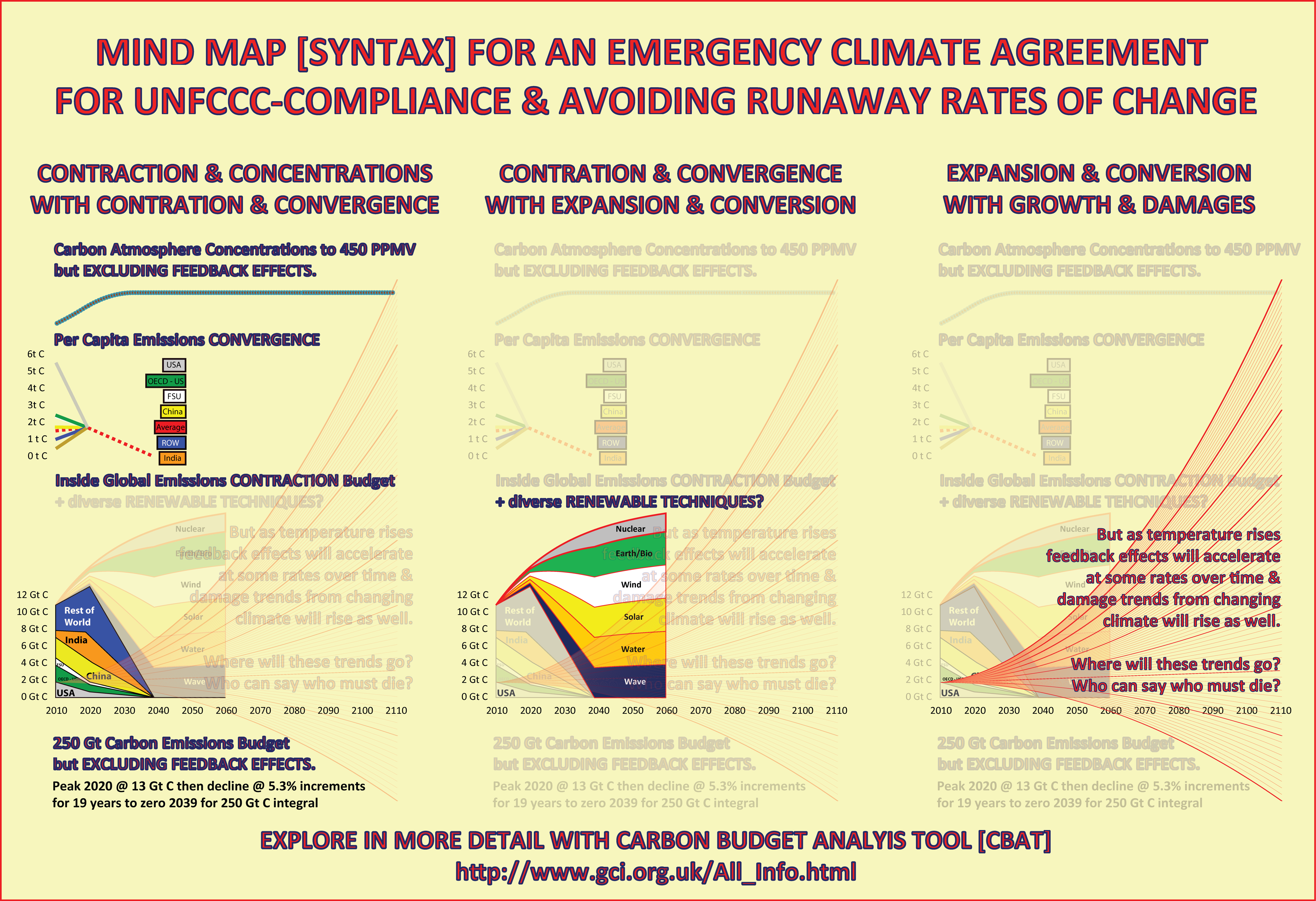
15 May 2014 - "Practical, sensible, clearly articulated - I support C&C." Dr Jenny Griffiths OBEDear Aubrey,
Thank you for your message. Please add my name to the list.
I support the Contraction and Convergence submission from GCI to the UNFCCC to promote climate justice in a practical, sensible, clearly-articulated way.
I have supported Contraction and Convergence in the publications:
"Sustaining a Healthy Future" (2008) (Faculty of Public Health) and
"The Health Practitioner's Guide to Climate Change" (Earthscan, 2009 - see p 89), for which I was lead editor.Best regards
Jenny
Jenny Griffiths OBE
Contraction and convergence
Contraction and convergence is a global framework – not yet adopted by the UK government – for tackling climate change through the equitable allocation of carbon rations. The ‘contraction’ component entails setting a global carbon budget, reducing or 'capping' this annually to an agreed level so that the planet's climate once again gains equilibrium. ‘Convergence’ entails giving an equal entitlement of the capped carbon to each of the four billion or so adult inhabitants of the globe. The disadvantaged – generally low carbon emitters – will have entitlements which would allow for economic and social development or which they could sell to high carbon emitters ie. richer, developed countries. The framework implies both carbon rationing and carbon trading. Contraction and convergence is viewed by many as central to discussions on tackling climate change and sustainable development because of its focus on equity - see
Sustaining a Healthy Future - Taking Action on Climate ChangeThis publication has been endorsed by:
Association of Directors of Public Health
British Trust for Conservation Volunteers
Chartered Institute of Environmental Health
Climate & Health Council
Commission for Architecture and the Built Environment
Institute of Public Health in Ireland
Local Government Association
Neil McKay, Chief Executive, NHS East of England
National Heart Forum
NHS Confederation
Royal College of Physicians of Edinburgh
Royal College of Physicians of London
Royal Institute of Public Health
Royal Society of Health
Scottish Healthy Environment Network Steering Group
Sustain
Sustainable Development Commission
Sustrans
UK Public Health Association
Produced in consultation with the Carbon Trust
"Preventing runaway climate change is essential for a healthy and sustainable future. However, the economic and social policies that will need to be implemented in order to reduce greenhouse gas emissions will also bring substantial health improvements. Specifically, they could bring important reductions in inequalities in health, heart disease, cancer, obesity, diabetes, road deaths and injuries and urban air pollution. These health benefits arise for three reasons: 1 Because Contraction and Convergence, which is the fairest, most clearly articulated and most widely supported global framework for reducing greenhouse gas emissions, has justice and equity at its core and injustice and inequality are major determinants of human suffering and sickness (Global Commons Institute, 2008). 2 Because climate change policies will impact in a health-promoting way on two of the most important determinants of health: human nutrition and human movement 3 Because climate change policy has to include population policy and the promotion of family planning has huge potential to improve global health (Cleland et al. 2006)."
The Health Practitioner's Guide to Climate Change
Jenny Griffiths (Editor), Mala Rao (Editor), Fiona Adshead (Editor), Allison Thorpe (Editor)
Action to reduce substantially carbon emissions in a way that is fair and equitable for all countries around the globe see Global Commons Institute’s policy of Contraction and Convergence, which is a carbon cap and trade policy designed to reduce CO2 emissions.
THE CONVERGENCE OF HEALTH AND SUSTAINABLE DEVELOPMENT
A MANIFESTO AND A NETWORKSIGNATORIES
Faculty of Public Health of the Royal Colleges of Physicians of the United Kingdom
Scottish Environmental Protection Agency
UK Public Health Association
Sheila Adam, Interim Regional Director of Public Health, NHS London
Edwina Affie, Public Health Consultant
John Ashton, title to be confirmed
Ian Baker, Hon. Reader in Public Health, University of Bristol
Geoff Barnes, Health Policy Adviser, Sustainable Development Commission
Ian Basnett, Assistant Director of Public Health, North East London Strategic Health Authority
Chris Bentley, Director of Public Health & Clinical Engagement, South Yorkshire Strategic Health Authority
Graham Bickler, Regional Director , South East Health Protection Agency
Chris Birt, Consultant / Honorary Senior Lecturer in Public Health, Central Liverpool PCT
Leslie Boydell, Consultant in Public Health Medicine, Institute of Public Health in Ireland
Nick Cavill, Cavill Associates
Sir Ken Collins, Chairman, Scottish Environment Protection Agency
Anna Coote, Public health specialist
Fiona Crawford, Public Health Programme Manager, Glasgow Centre for Population Health
Andrew Furber, Honorary Senior Clinical Lecturer/ Consultant in Public Health Medicine, South East Sheffield PCT
Campbell Gemmell, Chief Executive, Scottish Environment Protection Agency
Mike Gill, Visiting Professor in Public Health, University of Surrey
Sir Muir Gray, Director of Clinical Knowledge, Process and Safety, NHS Connecting for Health
Jenny Griffiths, independent consultant
Rod Griffiths, President, Faculty of Public Health
Siân Griffiths, Director, School of Public Health, The Chinese University of Hong Kong
Sir Andy Haines, Professor, London School of Hygiene and Tropical Medicine
Neil Hamlet, Consultant in Public Health Medicine, NHS Fife
John Harvey, Director of Public Health, Havering PCT
Tony Hedley, Chair Professor in Community Medicine, Department of Community Medicine, School of Public Health, The University of Hong Kong
Alison Hill, Director, South East Public Health Observatory
Linda Hillman, Consultant in Public Health and Dental Public Health, Norfolk Public Health Network.
Phil Insall, Director, Active Travel, Sustrans
Lizi Irvine, Senior Lecturer, Napier University, Edinburgh
Julie Hotchkiss, Director of Public Health, Ashton,Leigh & Wigan Primary Care Trust
Richard Jarvis, Consultant in Health Protection, Cheshire & Merseyside
Jack Jeffery, Immediate Past Chairman of the Royal Institute of Public Health and Director, Durham County Waste Management Ltd.
Alyson Learmonth, Director of Public Health and Health Improvement, Sedgefield PCT
Giovanni Leonardi, Consultant in Environmental Epidemiology, Health Protection Agency, Centre for Radiation, Chemical, and Environmental Hazards
Carolyn Lester, Lead for Health Inequalities & Equity, National Public Health Service for Wales
Ann McCarthy, Senior Lecturer, Division of Criminology, Public Health & Policy Studies, School of Social Sciences, The Nottingham Trent University
John Middleton, Director of Public Health, Sandwell
David Miles, Director of Public Health, West of Cornwall Primary Care Trust
Ruairidh Milne, Clinical Senior Lecturer, School of Medicine, University of Southampton
George Morris, Professor, Senior Medical Officer, Scottish Executive,
Maggi Morris Director of Public Health, Preston Primary Care Trust
Aldo Mussi, Snr Lecturer in Health Development, Faculty of Health, University of Central England
David Ogilvie, MRC fellow, MRC Social and Public Health Sciences Unit, Glasgow
Lindley Owen, Director, Mobilise! Project, Manager Sustrans Cornwall & Plymouth
David Pencheon, Director, Eastern Region Public Health Observatory
Cathy Read, Consultant in Public Health Medicine, Barnsley Primary Care Trust
Paul Redgrave, Director of Public Health, Barnsley Primary Care Trust
Sue Roaf, Councillor Professor, Oxford Brookes University
Ian Roberts, Professor of Epidemiology and Public Health, London School of Hygiene and Tropical Medicine
Helen Ross, Public Health Development Manager, Greater Nottingham Health and Environment Partnership,
Harry Rutter, Deputy Director, South East Public Health Observatory
Paul Scourfield, Chief Executive, Faculty of Public Heatlh
Jackie Spiby, Consultant in Public Health, North East London Strategic Health Authority
Cameron Stark, Consultant in Public Health, NHS Highland
Robin Stott, vice chair Medact
Jeremy Wight, Director of Public Health, North Sheffield Primary Care Trust
Ewan Wilkinson, Consultant in Public Health, Liverpool Primary Care Trusts
15 May 2014 - "You are most welcome to add my name as a (C&C) supporter." Prof Ulrich von Weizsacker Co-Chair IRP UNEPDear Aubrey,
You are most welcome adding my name as a supporter.
Best
Ernst
Prof. Dr. Dr. h.c. Ernst Ulrich von Weizsäcker
Co-Chair, International Resource Panel (UNEP)
P.O. Box 1547, 79305 Emmendingen, Germany
Having reviewed the trends in the use of natural resources and accompanying undesirable environ-mental impacts in the first section of Chapter 2, the last section of that chapter considers possible future implications by presenting three brief scenarios: (1) business as usual (leading to a tripling of global annual resource extraction by 2050); (2) moderate contraction and convergence (requiring industrialized countries to reduce their per capita resource consumption by half the rate for the year 2000); and (3) tough contraction and convergence (aimed at keeping global resource extraction at its current levels). None of these scenarios will lead to actual global reductions in resource use, but all indicate that substantial reductions in the resource requirements of economic activities will be necessary if the growing world population can expect to live under conditions of sustainable resource management. The key message of the tough scenario is that despite population growth to roughly 9 billion people, the pressure on the environment would remain roughly the same as it is now. The emissions correspond approximately to the lowest range of scenario B1 of the IPCC SRES, but are still 20% above the roughly 5.5 GtC/yr advocated by the Global Commons Institute for contraction and convergence in emissions (GCI, 2003).
UNEP - 2011: Decoupling Natrual Resource Use & Environmental Impacts from Economic Growth
Dr Ernst von Weizsacker, Dr Ashok Khosla, Co-Chairs International Resource Panel
15 May 2014 - "I support the C&C proposal." Associate Professor Tamas Szabados Budapest University of Technology & EconomicsDear Aubrey,
Yes, I support the GCI's C&C Proposal to the UNFCCC.
This is said, I think that tools for avoiding overpopulation of the world, including a table describing the approximate carrying capacity of human population in each country should be incorporated in your model. I think that the current situation in this respect is the worst in Africa, India and Bangladesh. Overpopulation may lead to a serious devaluation of human life and so threatens any rational effort that wishes to handle the problems the world faces, including climate change.
However, I appreciate very much your efforts to find a rational solution of the problem of climate change.
Kind regards,
Tamas Szabados PhD
Associate Professor of Mathematics
Budapest University of Technology and Economics
Hungary15 May 2014 - "Support the operational framework of C&C; what are we waiting for." Laurie Barlow Greensward Civitas PasadenaDear Aubrey
I completely support the adoption of the Contraction and Convergence Operational Framework submission to the UN Climate Negotiations.
This climate agreement model is a very transparent and fair methodology for setting the framework for convergence of carbon emission containment and regenerative ecological habitation by all countries. It is a very clear and rational approach based upon per capita allowances. It's a necessary step because the timeline to reduce human carbon emissions to zero is only 50 years, due to recent documented changes in the climate system.
Double-Jeopardy of unsustainable growth of human population demands and concomitant increased costs of climate damage is a very clear risk model, and it's shared by every country on the globe. It's the limit to growth problem, and the methods by which this risk is contained are grounded in the rapid evolution of renewable energy, conservation and ecological recovery. These things are eminently doable, as is evidenced by the rapid development of net-zero strategies by the building industry, and the capability for rapid energy production transformation as outlined by the Rocky Mountain Institute. Many regional projects around the globe have already regenerated their rivers, forests and resources as part of their development.
The costs of the impact of climate change, as the financial community has observed through its re-insurers, are running well ahead of rate of growth of the global economy. This creates destructive economic as well as physical vectors and generates a future of great uncertainty for all countries. Destabilization of climate, food and water supplies, energy and resources come as an ultimate price of unchecked growth, placing this huge cost upon every country on the planet. Thus the argument that carbon emissions can continue going forward is shown to be utterly destructive to all human societies and living systems by the projections in this model.
Therefore the choice is not whether to agree, but how swiftly this method needs to be put into place. The sooner it is achieved, the better the future is for all countries, and the damage to human life, as well as to all life and ecological systems can be minimized both economically and in terms of resources.
This is a shift in the idea that human existence requires continuous expansion; rather it focuses on the quality of life on earth and the idea that a less mechanistic existence requires fewer resources and fosters the regeneration of that which supports life for all. Human suffering and extinction of natural processes are not rational choices under this model, which is something that can be agreed to in principle very quickly by all countries; the stakes are clear.
How this is achieved is left up to individual countries and fostered by ability of low-emission countries to create value for their renewal strategies and low carbon levels. This creates an incentive game where this value is sought after, thus creating a market for non-emission of carbon. It's the inverse of how fossil-fueled capitalism works now, but uses the same kind of fiscal incentives, and creates an entire new paradigm for human existence within the natural world that stabilizes the future and allows the earth to regenerate.
Sincerely,
Laurie Barlow,
AIA San Marino,
California
United States of America
http://www.barlowcoweb.com/
http://greenswardcivitas.blogspot.com/ Full article here - "A Fair Consensus" by Laurie Barlow
Full article here - "A Fair Consensus" by Laurie BarlowIn support of the Contraction and Convergence submission to the UN Climate Negotiations (UNFCCC) in February of this year by Aubrey Meyer (in video above) of the Global Commons Institute, I'm dedicating this post to the implementation of its framework.
This climate agreement model is a very transparent and fair methodology for setting the framework for convergence of carbon emission containment and regenerative ecological habitation by all countries. It is a very clear and rational approach based upon per capita allowances. It's a necessary step because the timeline to reduce human carbon emissions to zero is only 50 years, due to recent documented changes in the climate system.
Double-Jeopardy of unsustainable growth of human population demands and concomitant increased costs of climate damage is a very clear risk model, and it's shared by every country on the globe. It's the limit to growth problem, and the methods by which this risk is contained are grounded in the rapid evolution of renewable energy, conservation and ecological recovery. These things are eminently doable, as is evidenced by the rapid development of net-zero strategies by the building industry, and the capability for rapid energy production transformation as outlined by the Rocky Mountain Institute. Many regional projects around the globe have already regenerated their rivers, forests and resources as part of their development.
The costs of the impact of climate change, as the financial community has observed through its re-insurers, are running well ahead of rate of growth of the global economy. This creates destructive economic as well as physical vectors and generates a future of great uncertainty for all countries. Destabilization of climate, food and water supplies, energy and resources come as an ultimate price of unchecked growth, placing this huge cost upon every country on the planet. Thus the argument that carbon emissions can continue going forward is shown to be utterly destructive to all human societies and living systems by the projections in this model.
Therefore the choice is not whether to agree, but how swiftly this method needs to be put into place. The sooner it is achieved, the better the future is for all countries, and the damage to human life, as well as to all life and ecological systems can be minimized both economically and in terms of resources.
This is a shift in the idea that human existence requires continuous expansion; rather it focuses on the quality of life on earth and the idea that a less mechanistic existence requires fewer resources and fosters the regeneration of that which supports life for all. Human suffering and extinction of natural processes are not rational choices under this model, which is something that can be agreed to in principle very quickly by all countries; the stakes are clear.
How this is achieved is left up to individual countries and fostered by ability of low-emission countries to create value for their renewal strategies and low carbon levels. This creates an incentive game where this value is sought after, thus creating a market for non-emission of carbon. It's the inverse of how fossil-fueled capitalism works now, but uses the same kind of fiscal incentives, and creates an entire new paradigm for human existence within the natural world that stabilizes the future and allows the earth to regenerate.
The UN Climate Change Conference last December unfortunately came to a close with no agreement on global NEA goals. National Emissions Allocations are distributed through a global agreement of quotas of allowed emissions per capita for each country. This was proposed by the Global Commons Institute in 2000, and is conceptually accepted as a methodology by many countries. The NEA- based contraction convergence model applies an emissions cap to each country that declines rapidly over 40 years in order to reach the desired global atmospheric goal of 430 ppmv by 2052 (we're at 395 now). It's a cooperative effort, with developed nations assisting the third world countries in their reduction via the transfer of energy and pollution control technologies. Its strategy is that rapidly developing countries such as China and India must quickly pull back on their increasing emissions, and the UK and USA must simply implement immediate reductions in GHG emissions, period. This proved untenable to developed countries at Durban in December 2011, and so no global agreement was achieved. There is a consensus on the model, however, so the negotiation continues.
The Global Commons Institute [GCI] was founded in 1990. It has developed thisemissions management model that has gained support by many countries as a fair and effective model for reducing carbon emissions.
Mindfulness.
A proposed strategy for counteracting human activity in the biosphere as a comprehensive approach is called the Contraction and Convergence model. It sets up the framework whereby all countries accept a carbon budget that shrinks rapidly during the convergence phase between 2000 and 2030, resulting in a diminishment of carbon emissions to the levels seen in 1900 within 200 years. Will this be sufficient to preserve the planetary systems as we know them today? We may have a difficult time maintaining human life, not to mention the rest of the life systems that give us sustenance.
Mindfulness is concentration on the nature of life and all its parts. This way of seeing can allow us to act in effective ways that return our world to its natural balance and respect for life, rather than mindlessly burning resources into destruction. The science says that, and the experiential says that. Even simple logic says that.
So what are we waiting for?
Civitas on Contraction and Convergence15 May 2014 - "C&C - the skill & art of the Long View." Jelle Hielkema FAO Rtd"Aubrey Meyer has credibly conceived 'Contraction and Convergence (C&C)' for the Common Good of Humanity with the skill of 'the Art of the Long View', so sadly missing in this world's political 'scheme of play'! Yet, without a C&C mechanism in place it's becoming more and more obvious that our children and particularly their children will have to 'deal and cope' with a world increasingly beleaguered by its own seriously modified planetary climate. No denying of that anymore and 'those in charge' better wake up to that stark Reality and act accordingly!"
This short paper takes a ‘Chaldean algorithm’ and suggests the relationships between music, mathematics, meaning and international efforts to deal with climate change. Taking a cyclic view, the ‘stringularity’ of a full-term C&C-event needs to complete within about the next five of these ‘eight-earth-year-cycles’, if dangerous rates of climate change are yet to be avoided. Imagine being kissed by Venus 25 times in the next 40 Years.
Pythagoras Renewed for Our Common Global Future
Aubrey Meyer & Jelle Hielkema15 May 2014 - "I support this (C&C) proposal." Dave Hampton the Carbon CoachYes please, I support this proposal.
Dave Hampton The Carbon Coach MA (Cantab) C Env C Eng
Board Member of The Society for the Environment
RIBA Sustainable Futures, The Edge, Marlow FM Radio
Star attraction was Dave Hampton, The Carbon Coach - an expert consultant in personal and corporate carbon reduction targets. He regularly demonstrates to audiences of all ages the scale and significance of our personal carbon emissions with the help of some specially designed purple helium-filled balloons.Unfazed by a gaggle of overenthusiastic schoolchildren, Mr. Hampton patiently explained ‘Contraction and Convergence’ and the significance of their participation in the shoot.
Contraction and convergence (C&C) is a proposed strategy for reducing greenhouse gas emissions to combat climate change. Conceived by the Global Commons Institute in the early 1990’s, the Contraction and Convergence strategy consists of reducing overall emissions of greenhouse gases to a safe level, ’Contraction’, where the global emissions are reduced because every country brings emissions per capita to a level which is equal for all countries, ’Convergence’.
It is intended to form the basis of an international agreement which will reduce carbon emissions to avoid climate change."There is something deeply unifying and healing about C&C, if we can let it into our hearts."
C&C is Beautiful Dave Hampton
C&C STARTS to reverse the process of growth of EXPANSION AND DIVERGENCE (the whole rich get richer dream/nightmare) and it starts to heal and reconcile and unify and take us forward not in fairness - but towards fairness. It's unreasonable for rich to ask poor to back it - but I sure hope they do. Aubrey Meyer points to MANDELA words it being about JUSTICE without VENGEANCE? I love C&C and I hope that all our leaders learn to love it and lead with it and soon.
What Would Gandhi Do?
Dave Hampton the Carbon Coach in Carbon Sense
Dave Hampton says, “It’s all common sense really, and it’s reality, so it’s common sense reality I suppose - another kind of CSR?!”
Contraction and Convergence
15 May 2014 - "I assure you of my ongoing & dedicated support for the C&C Principle." Rabbi Jeffrey NewmanDear Aubrey,
When I first realized that the world is standing by, watching the destruction of millions, or hundreds of millions of its inhabitants through climate change - heat, drought, food scarcity and so on - it reminded me of those who 'stood by' and watched the deliberate attempted annihilation of the Jewish people. This new genocide is avoidable and I am writing to assure you of my on-going, dedicated support for the principle of Contraction and Convergence.
As I understand it, this is an equitable, essentially simple, mathematical formula through which it becomes possible for scientists to calculate the Carbon Emissions which the planet can sustain at any time and to determine the per capita (tradable) allowances for fair distribution.
The sooner the formula or one clearly based upon it is adopted, the sooner futile arguments, obfuscation and delay can be ended and there can be a determined effort to reduce our fossil fuel energy use and replace them with renewable.
I will do all I can to support you and others in publicising your idea and turning it into reality.
In friendship and with love,
Jeffrey
Rabbi Jeffrey Newman
~~~~~~~~~~~~~~~~~~~~~~~~~~
Dear Jeffrey
Thank you for this heartfelt message.
The whole 'genocide' angle on this story is almost too dreadful to contemplate. The precedent of looking away as you suggest is difficult to refute. But, as before, it is looking away that turns us to stone so face it we must.
There have been times when one feels cast down as the issue is so huge and this effort has just seemed futile. But knowing that you are committed to bringing C&C to bear is uplifting to me . . . .
. . . and there are others now, so hope springs eternal . . . .
With the greatest respect and affection to you,
Aubrey
~~~~~~~~~~~~~~~~~~~~~~~~~~
‘I have set before you life and death, the blessing and the curse. Therefore, choose life’. (Deuteronomy 30:19)
In February, the Board of Deputies of British Jews,an august and somewhat conservative body more usually concerned with anti-Semitism and defence of Israel than with the environment, inaugurated a new web-site hosted by Operation Noah,an environmental group celebrating its tenth anniversary. The web-site highlights good practice and encourages the community, both individuals and synagogues, to change behaviour. Currently under consideration is an ambitious proposal to ‘green the community’ by providing model projects of energy conservation and renewable generation for communal institutions, schools, synagogues and families.
One group, the Rabbis of the Reform Movement, has voted to endorse the Earth Charter, a global declaration of principles for a just, sustainable and peaceful twenty-first century and are now being urged to join the Archbishop of Canterbury in campaigning for Contraction and Convergence. This is an international movement asking governments of the world to agree to contract the amount of greenhouse gases going into the atmosphere to an amount the Earth can bear and share out the right to emit greenhouse gases on a per-head-of-population basis.
Those richer countries where the emissions far outweigh the population, in justice,pay for their surplus and the payments go to those countries where the emissions are much less but the populations much greater, namely the developing world.
Dominion or Degradation - Rabbi Jeffrey Newman
"Anyone who thinks C&C is Utopian simply hasn't considered the alternatives honestly."
Rowan Williams - Archbishop of Canterbury
Rabbi Jeffrey Newman agrees with Archbishop Rowan WilliamsDavid Hare Interview with Archbishop Rowan Williams in the Guardian Magazine 8th July, 2011
I ask if that's the criterion – that the world should make sense. "Make sense not in a great theoretical system, but that you can see the connections somehow and – I tend to reach for musical analogies here – you can hear the harmonics.
You may not have everything tied up in every detail, but there's enough of that harmonic available to think, 'OK, I can risk aligning myself with this.' Because you're never going to nail it to the floor and eat your heart out, Richard Dawkins!
"You know that scene in the Woody Allen film where they have an argument in a cinema queue, and Marshall McLuhan is standing behind them and able to interrupt to settle the argument? Woody Allen turns to the camera and says, 'Wouldn't it be wonderful if life were like that?' Well, no Marshall McLuhan will ever step forward in the queue and say to Richard Dawkins, 'The archbishop's right.' It's not going to happen."
ABC is on record with accomplished C&C advocacy in the CoE dcoument 'Sharing God's Planet' and on page 66 of the DAVOS document Faith and the Global Agenda: Values for the Post-Crisis Economy . . .
. . . . and Richard Dawkins will yet make his peace with Plato.
~~~~~~~~~~~~~~~~~~~~~~~~~~~~~
15 May 2014 - "Happy to support C&C proposal to the UNFCCC." Prof David Huddart Liverpool John Moores UniversityAubrey,
I would be happy to support GCI's current C&C proposal to UNFCCC.
There is an immediate need for more action on climate change and a response from all governments and international organisations like the United Nations.
Individuals too can help in this and educational establishments like ours can educate students in a positive manner.
Best Wishes
David
Professor David Huddart
Director of Research Faculty of Education,
Community and Leisure
I.M.Marsh Campus
Liverpool John Moores University
Contraction and converqence: The last hope?
Surporled by China, Germany, The European Parliament, Stern and many others, this concept is on the idea that everyone on planet Earth has the right to emit the same quantity of GHG. At present a US citizen emits 20 tonnes of CO2 each year, a UK citizen emits 11 tonnes while a Nigerian only emits 0.09 tonnes. Contraction and Convergence [C&C] is the Global Commone Institute's proposed UNFCCC-compliant climate mitigation strategy for an equitable solution to cutting greenhouse gas emissions through collective global action.The ultimate objective of the UN Climate Treaty is to move to safe and stable GHG concentration in the atmosphere and C&C starts with this. C&C recognizes that subject to this limit, we all have an equal entitlement to emit GHGs to the atmosphere, since continuing unequal use will make it impossible to get global agreement needed for success. The Kyoto Protocol cannot be the basis of this success, because it is not science-based and, due to divergent national interests, it does not include all countries.
Scientists have advised on safe concentration of CO2 in the atmosphere and on the global cap on emissions necessary to achieve it. A level of 450 ppmv has until recently been regarded as the upper limit for keeping under the maximum temperature oncrease of 2 degrees above the pre-industrial average.
From the inception of a global agreement, C&C schedules the mandatory annual global contraction [reduction of emissions] that will keep CO2 concentrations from rising beyond the agreed safe level. This rate of contraction must be periodically adjusted to take account of the increasing release of GHGs caused by climate warming. C&C proposes emissions entitlements to every country. While starting with current emissions, it proposes a scheduled convergence to equal per person entitlements for everyone on the planet by an agreed date [see figure above]. That way, convergence will reduce the carbon shares of the developed over-emitting countries sharply until they converge with the [temporarily rising] shares of the developing countries. The latter will be able to sell their surplus carbon shares to the wealthier nations. Emissions trading will be subject to rapid investment in renewable energy.
The 14th session of the Conference of the Parties to the Climate Change Convention [COP-14] will be held in conjunction with the 4th Conference of the Parties serving as the Meeting of the Parties to the Kyoto Protocol [COP 14] in Poznan, Poland, from 1 to 12 December 2008. In 2012 the Kyoto Protocol expires. To keep the process going there is an urgent need for a new climate protocol. In 2012 the Kyoto Protocol runs out. It is to be hoped that discussions at the Climate Conference in Copenhagen in 2009 and subsequent agreements lead to a Copenhagen Protocol to prevent global warming and climate change.
Earth Environments: Past, Present and Future
By David Huddart, Tim Stott
15 May 2014 - "I support GCI's C&C submission." Dr Robin Attfield Cardiff UniversityDear Aubrey,
I support the GCI submission.
Best wishes
Robin
Professor Robin Attfield
Professor of Philosophy
Cardiff University
Extended and very strong C&C advocacy in
Human Ecology Review
Global Warming, Equity and Future Generationsby
Robin Attfield
Cardiff University
United Kingdom"Contraction & Convergence probably remains the best prospect for addressing the global problems of mitigation and adaptation, and at the same time a promising spring-board for achieving a global agreement on addressing the problems of poverty and under-development of the kind that is also urgently needed."
Contraction and Convergence would not solve everything and would need to be supplemented but objections do not show that it is either ungrounded or not a large move in the right direction.There are, in any case, severe problems in basing international policies not on emissions quotas but (as has been suggested) instead on requiring developed nations and wealthy individuals to pay both for development, for mitigation and for adaptation for climate change. Here the risks of large-scale non-compliance (in what would have to be an intense and global program of action introduced with little prior notice) are so large that it would be hazardous to make the entire future of humanity depend on its success.
The real objection to such proposals is that concern for the future of humanity and of other species requires a system answering to current capacities and capable of being extended indefinitely into the future, in other words sustainability; thus, the approach based on historical responsibilities cannot match these requirements. The system needed would have to be based on universal principles, including current prosperity and cannot be derived from the particularities of history.
This reasoning strongly points to a system based on Contraction and Convergence, even though it would need to be supplemented by a massive system to combat poverty and underdevelopment. The latter, could well need to be introduced simultaneously in the cause of securing universal agreement about and compliance with the system of proportion ate emissions quotas.
GLOBAL WARMING, EQUITY & FUTURE GENERATIONS ROBIN ATTFIELD
15 May 2014 - "I strongly support C&C." Professor Ian Lowe Griffiths University AustraliaDear Aubrey
I strongly support Contraction and Convergence.
It is the only mechanism which combines environmental responsibility with social justice to provide a potentially viable solution to the problem of global climate change.
Best wishes
Ian Lowe
Emeritus Professor of Science, Technology and Society, Griffith University
President, Australian Conservation Foundation
The Earth Charter Initiative is a broad-based, voluntary, diverse, global network of people, organisations and institutions which participates in promoting and implementing the values and principles of the Earth Charter. Members include leading international institutions, cational governments and their agencies university associations, non-government organisations and community-based groups, city governments, faith groups, schools and businesses as well as thousands of individuals. The Earth Charter embodies the fundamental principles of a new global ethics under four broad headings: I) respect and care for the community of life; 2) ecological integrity; 3) social and economic justice; and 4) democracy, non-violence and peace. Australian environmental groups have worked strongly for decades on the first two of these. There is now an increasing recognition that solving the complex problems we face demands an integrated approach. Solutions to our environmental problems will not be socially and politically sustainable unless they are based on social and economic justice. This is most obviously true of climate change, which can only he solved if the developed nations accept their responsibility for causing the problem as well as accepting the legitimate demands of poorer countries to improve their material wellbeing. These principles lead inexorably to a 'contract and converge’ model in which the Earth's capacity to absorb carbon dioxide is much more equitably allocated.
Voice of Reason,
Ian Lowe
15 May 2014 - "It will be a pleasure to take part in this initiative." Dr Mohamed Behnassi IBN ZOHR University MoroccoDear colleague,
Please add my name to the list. It will be a pleasure to take part in this initiative.
Cordially
Dr Mohamed Behnassi
Dr. Mohamed Behnassi
Associate Professor
Faculty of Law, Economics and Social Sciences
IBN ZOHR UNIVERSITY
Post-Doc, Faculty of Law, Economics and Social Sciences
Other Affiliations:
North-South Centre for Social Sciences-NRCS, Global Sustainability and Health Politics
Whilst we can encourage small-scale livestock production for family and local use in poorer nations, those eat high up the food chain surely have a moral oblication to reduce their consumption of animal products. We can eat less so that they can eat more. This theory of contraction and convergence has been outlined by leading public health academics such as Tony McMichael. He and his colleagues believe that those in the developed countries should reduce their meat consumption to no more than 90 gm a day as this would be better for the climate and for their own health (McMichael et al 2007). Those in the developing world could eat more meat until they too reached this level. Even 90 gm a day only helps to stablize and not itself reduce GHG emissions figures.
Global Food Insecurity
Mohamed Behnassi, Sidney Draggan, Sanni Yaya
15 May 2014 - "I will with pleasure be a co-signatory to C&C proposal." Dr Robin StottDear Aubrey,
Thanks as ever for your unremitting efforts
I will with pleasure be a co-signatory.
Lets hope sense will prevail, and we can get some forward movement.Best wishes
Robin
SPOTLIGHT: CLIMATE CHANGE
The most feasible present framework that embraces these principles is contraction and convergence (C&C). C&C is based on the science of limits and the logic of global rights. The global total of permitted emissions is calculated so as to achieve the objective of limiting and stabilising atmospheric carbon concentrations below the level beyond which runaway climate change becomes unavoidable (presently thought to be about 400 parts per million). This calculated amount of carbon (the global carbon budget) provides the quantum from which an inclusive, global, equal rights per capita entitlement of carbon is derived; an entitlement that will go to each adult. Emissions trading can then take place within the context of this scientifically calculated carbon budget and the rights based mechanism for distribution.
The implementation of a framework founded on these principles will require tough negotiation, particularly around the speed of convergence to an equal per capita entitlement of carbon dioxide emissions, which can be no more than one and a half tonnes per person by 2050 (assuming a global population of 9 billion). Calculation of the initial carbon budget takes account of the present capacity of the global sinks: the oceans, soils, forests, and other flora that absorb CO2. If these sinks diminish, C&C enables the necessary recalculation; the contraction and convergence framework has the capacity to be modified in relation to evolving risks.
How will C&C work?
The equal per capita entitlement of carbon emissions can be pre-distributed as carbon coupons to consumers who could then negotiate the sale of these coupons. Under-consumers (generally the poor) will have coupons to sell to over-consumers (generally the rich). Market forces will work for the poor as well as to reduce carbon emissions; a key feature of the scheme. Putting the poor in control is a crucial development goal, as evidenced by the recent moves by donor agencies such as the International Red Cross to simply give cash to the poor. Recent publications testify to the efficacy of this approach. Equal entitlement under C&C has the added advantage that, in the early stages of the implementation of the framework, rapidly industrialising countries such as China, India, and Brazil (which are still relatively low per capita emitters of carbon) will be beneficiaries.
Credits (entitlements) will be issued by the global institution that oversees global sustainable development and agrees and implements C&C. C&C envisages that a greater portion of these entitlements are delivered to individuals or small collectives. This commitment can be written into the global agreements. So also can the proportion of the entitlements that would be held by the country level group to cover communal facilities such as schools and hospitals. For instance, in the UK, the proportion of carbon emitted by collective rather than individual actions is around 40%, an indication of the proportion of entitlements that the UK would hold centrally.
The widespread uptake of microcredit and the penetration of electronic communication, especially mobile phone technology, provides a route for implementing C&C in poorer countries. And although C&C encourages low carbon solutions, it does not seek to define those solutions for any particular group. The agency of individuals and communities to use resources as they think best makes C&C nonintrusive and is one of the socially attractive properties of the scheme.
No other framework quantifies allowable carbon emissions against an atmospheric CO2 concentration. No other framework allocates entitlements of this amount in a way which is to the advantage of underprivileged people in both the countries that are yet to industrialise and the rapidly industrialising countries. These unique features account for the significant level of global support for C&C, support which will be essential to getting the framework implemented. During the implementation of C&C, a period of no more than a few years, a low carbon development fund of at least $150bn must immediately be established. Much of the money could be raised by a tax on airline tickets and imposition of a $5 tax on each of the 20 billion barrels of oil used by OECD countries each year, or through the introduction of a financial transaction tax as advocated by Nobel prize winning economist James Tobin.
Time is of the essence. This is well understood by health professionals. After any serious trauma, a patient’s chances of recovery are much greater if treatment is started within one hour of the event: the so called golden hour. Our traumatised globe is nearing the end of its golden hour. For the sake of present and future generations, we have to move quickly for our interventions to successfully heal the globe. An agreement to implement C&C cannot be delayed.
Robin Stott - Contraction & convergence:
the best possible solution to the twin problems of climate change and inequity.
Over the past 20 years the view that human activity is disturbing the normal cycles of climate change has become widely supported by scientists. Fossil fuel burning has amplified changes in greenhouse gasses so that whereas levels of Carbon Dioxide have been below 300 parts per million over the past million years, they are now 380 ppm and rising rapidly. We doctors have explored and documented the likely health consequences of these changes. These are both direct, as in the extension of vector borne diseases associated with warming climates, and indirect, through for example crop failure due to changing weather patterns. The potential for a devastating impact on the health of all peoples is now clear, and if that was the end of the story, we would have reason to be despairing. Fortunately, there is another narrative, a narrative which gives us reason for optimism and a basis for effective action. Tackling climate change by radically reducing global fossil fuel use, but doing this in a way which enables poor countries to have headroom for development, will be of major benefit to health. This health promoting framework for tackling climate change is called Contraction and Convergence - reducing the global carbon emissions, and dividing the residual carbon into equal entitlements for all adults. The consequence for health in our own country will be a phased increase in exercise, improving air quality, the greening of public spaces, and an improving diet with a decrease in meat consumption. When we consider that the majority of chronic disease is due to lack of exercise, inappropriate diets and poor air quality, this essential measure to tackle climate change transforms into an essential measure for tackling chronic disease. More widely the equal entitlement of carbon means that whilst we in the rich countries have to radically reduce our use of fossil fuels, those in poor countries have opportunities to sell some of their entitlement to us, and to use the rest to transform their societies. So ‘Whats good for climate change is good for health.” Through tackling climate change in this fair shares way we deliver benefits to our individual patients and to many others around the globe. The Climate and Health Council, which I co-chair, and of which Tim Ballard is a member, asks you to join us in ensuring that this transformative view of climate change is taken seriously in all negotiations. Go to our website, which suggests a range of actions you can take. In particular we ask you to sign our pledge. 6000 health professionals from many countries have already signed, and by adding your name we will get increasing evidence of our commitment to tackle climate change. We can use this evidence to give our negotiators the courage and space to make the appropriate decisions both nationally and internationally.
Robin Stott - Co-chair, Climate and Health Council
Contraction and convergence
Royal College of General Practitioners
Dr Robin Stott on Contraction and Convergence
"A science-based framework that makes sense".
Action to reduce substantially carbon emissions in a way that is fair and equitable for all countries around the globe see Global Commons Institute’s policy of Contraction and Convergence, which is a carbon cap and trade policy designed to reduce CO2 emissions.
THE CONVERGENCE OF HEALTH AND SUSTAINABLE DEVELOPMENT
A MANIFESTO AND A NETWORKSIGNATORIES
Faculty of Public Health of the Royal Colleges of Physicians of the United Kingdom
Scottish Environmental Protection Agency
UK Public Health Association
Sheila Adam, Interim Regional Director of Public Health, NHS London
Edwina Affie, Public Health Consultant
John Ashton, title to be confirmed
Ian Baker, Hon. Reader in Public Health, University of Bristol
Geoff Barnes, Health Policy Adviser, Sustainable Development Commission
Ian Basnett, Assistant Director of Public Health, North East London Strategic Health Authority
Chris Bentley, Director of Public Health & Clinical Engagement, South Yorkshire Strategic Health Authority
Graham Bickler, Regional Director , South East Health Protection Agency
Chris Birt, Consultant / Honorary Senior Lecturer in Public Health, Central Liverpool PCT
Leslie Boydell, Consultant in Public Health Medicine, Institute of Public Health in Ireland
Nick Cavill, Cavill Associates
Sir Ken Collins, Chairman, Scottish Environment Protection Agency
Anna Coote, Public health specialist
Fiona Crawford, Public Health Programme Manager, Glasgow Centre for Population Health
Andrew Furber, Honorary Senior Clinical Lecturer/ Consultant in Public Health Medicine, South East Sheffield PCT
Campbell Gemmell, Chief Executive, Scottish Environment Protection Agency
Mike Gill, Visiting Professor in Public Health, University of Surrey
Sir Muir Gray, Director of Clinical Knowledge, Process and Safety, NHS Connecting for Health
Jenny Griffiths, independent consultant
Rod Griffiths, President, Faculty of Public Health
Siân Griffiths, Director, School of Public Health, The Chinese University of Hong Kong
Sir Andy Haines, Professor, London School of Hygiene and Tropical Medicine
Neil Hamlet, Consultant in Public Health Medicine, NHS Fife
John Harvey, Director of Public Health, Havering PCT
Tony Hedley, Chair Professor in Community Medicine, Department of Community Medicine, School of Public Health, The University of Hong Kong
Alison Hill, Director, South East Public Health Observatory
Linda Hillman, Consultant in Public Health and Dental Public Health, Norfolk Public Health Network.
Phil Insall, Director, Active Travel, Sustrans
Lizi Irvine, Senior Lecturer, Napier University, Edinburgh
Julie Hotchkiss, Director of Public Health, Ashton,Leigh & Wigan Primary Care Trust
Richard Jarvis, Consultant in Health Protection, Cheshire & Merseyside
Jack Jeffery, Immediate Past Chairman of the Royal Institute of Public Health and Director, Durham County Waste Management Ltd.
Alyson Learmonth, Director of Public Health and Health Improvement, Sedgefield PCT
Giovanni Leonardi, Consultant in Environmental Epidemiology, Health Protection Agency, Centre for Radiation, Chemical, and Environmental Hazards
Carolyn Lester, Lead for Health Inequalities & Equity, National Public Health Service for Wales
Ann McCarthy, Senior Lecturer, Division of Criminology, Public Health & Policy Studies, School of Social Sciences, The Nottingham Trent University
John Middleton, Director of Public Health, Sandwell
David Miles, Director of Public Health, West of Cornwall Primary Care Trust
Ruairidh Milne, Clinical Senior Lecturer, School of Medicine, University of Southampton
George Morris, Professor, Senior Medical Officer, Scottish Executive,
Maggi Morris Director of Public Health, Preston Primary Care Trust
Aldo Mussi, Snr Lecturer in Health Development, Faculty of Health, University of Central England
David Ogilvie, MRC fellow, MRC Social and Public Health Sciences Unit, Glasgow
Lindley Owen, Director, Mobilise! Project, Manager Sustrans Cornwall & Plymouth
David Pencheon, Director, Eastern Region Public Health Observatory
Cathy Read, Consultant in Public Health Medicine, Barnsley Primary Care Trust
Paul Redgrave, Director of Public Health, Barnsley Primary Care Trust
Sue Roaf, Councillor Professor, Oxford Brookes University
Ian Roberts, Professor of Epidemiology and Public Health, London School of Hygiene and Tropical Medicine
Helen Ross, Public Health Development Manager, Greater Nottingham Health and Environment Partnership,
Harry Rutter, Deputy Director, South East Public Health Observatory
Paul Scourfield, Chief Executive, Faculty of Public Heatlh
CONTRACTION AND CONVERGENCE An exemplary global framework
‘Contraction and Convergence’ is a strategy aimed at capping and then reducing carbon dioxide emissions (contraction) and by giving an equal entitlement of the capped carbon to every adult, ensuring that all get fair shares of this capped global carbon allocation (convergence).
Climate change, poverty and war Robin Stott
JOURNAL OF THE ROYAL SOCIETY OF MEDICINE Volume 100 September 2007
Jackie Spiby, Consultant in Public Health, North East London Strategic Health Authority
Cameron Stark, Consultant in Public Health, NHS Highland
Robin Stott, vice chair Medact
Jeremy Wight, Director of Public Health, North Sheffield Primary Care Trust
Ewan Wilkinson, Consultant in Public Health, Liverpool Primary Care Trusts
15 May 2014 - "I support the C&C proposal." Professor Konrad Ott University of GriefswaldDear Aubrey
I support the C&C proposal!
Best
Konrad
Professor Konrad Ott
University of Griefswald
He has a recent article "Domains of Climate Ethics" in the "Yearbook of Science and Ethics" ["Jahrbuch für Wissenschaft und Ethik", Vol. 16.]
The attractiveness of GDR has faded at a closer look. In terms of political feasibility, C&C has clear advantages because some high-rank politicians, like Angela Merkel, have verbally agreed upon the C&C idea. For Northern countries, the economic impacts of C&C are severe but viable under a prudent long-term transition management while the distribution effects of GDR might be beyond control. The North clearly is not bankrupt after the financial crisis of 2009 but the effects of a GDR regime on employment, on domestic social security systems, and on taxation schemes have not been assessed yet. Even from an ethical perspective GDR must be seen with a critical lens because it combines an emergency ethics that allows for uncommon measures with a highly conventional approach to development as being defined in terms of monetary income. GDR seems to place the right to create monetary income at the centre of the system of human rights. If so, there are reasons to claim that a C&C-concept that must be enlarged to the domain of adaptation and might adopt some important points from GDR is, all things considered, the ‘better’ concept.
Domains of Climate Ethics; Konrad Ott
Jahrbuch fur Wissenschaft und Ethik~~~~~~~~~~~~~~~~~~~~~~~~~~~~
In 48 points or “better steps”, German philosopher and envrionmental ethicist Konrad Ott continues "Kronolid’s struggle with the ethical implications of climate change by elaborating basic foundations on existing and necessary policies for climate change. The short sections are consistently formulated as “ethical claims” and the reader should approach these slowly and with concentration, so that the subsequent steps are converted into one single walk and path.At the core of the author’s argument lies the climate-ethics concept of “Contraction and Convergence”. This argument provokes a constructive debate, and it presumes to to support a concept that has been regarded as “Utopian a decade ago but has now entered the political stage. What might it contribute to international climate policy in a nondistant future?
Religion and Dangerous Environmental Change
Sigurd Bergmann Dieter Gerten [Eds]Contraction & Convergence and Greenhouse Development Rights:
A Critical Comparison Between Two Salient Climate-Ethical Concepts
"All in all C&C is the preferable concept."
Two models are currently being pitted against one another in the discussion of a fair climate regime: Contraction and Convergence (C&C) and Greenhouse Development Rights (GDR s). The controversy revolves around issues of fairness and feasibility, and the question of how fair is fair enough. Other approaches with the potential to mitigate emissions fairly are not in discussion at present. The debate over these concepts is vital, as having actors who are individually committed to ambitious goals but divided at the conceptual level could prove fatal for climate policy as a whole. The following is an overview in the magazine of the Heirich Boell Foundations of the core elements of both with Katrin Krause and Konrad Ott for C&C and Tilman Santarius for GDRs.
How Fair is fair Enough?Dear Konrad
Thank you so much for writing and for sharing the article in "Jahrbuch für Wissenschaft und Ethik", Vol. 16.
I think it is very useful and I certainly hope it will be.I do agree with your point: -
"It would be deplorable if members of the political camp that supports most principles, objectives, and strategies outlined in the previous sections of this article might split into supporters of two competing ethical concepts, Contraction and Convergence (C&C) 59 and Greenhouse Development Rights (GDR) 60."
It would be deplorable if we did that. [Sadly it already is]. The moral point that GDR's seeks to emphasize [the enormity of the 'climate-debt' and the 'climate-cisis'] is justified and this twin problem continues as the economics of 'Expansion and Divergence' still informs the policy debate. After 23 years I can say that resolving this twin-problem has proved to be really daunting, as a form of reciprocal blackmail still seems to inform the negotiations.
GDR advocacy has been making the case that C&C has under-recognized this twin problem. I think this is error. In my view, doing this has been at the expense of what the politicians and the diplomats at the UNFCCC can realistically do to make arrangements for UNFCCC-compliance.
From the outset C&C sought not to continue a culture of adversarial engagement but to connect with the unifying logic that necessarily governs the collective efforts to become UNFCCC-compliant. In practice, GDR seems to deepen that adversarial tendency and so decrease prospects for detente.
On this matter I think a way forward is: -
[a] to see C&C as the basic organizing structure and then - on that basis - as you suggest, to welcome
[b] any additional 'compensatory' arrangements that can be agreed
[c] to see [b] as ineffective without [a].This is what I have sought to project to UNFCCC in the memo requested at COP-17 for 'increased ambition': -
Regarding Decisions at COP-17 for ‘increased ambition’ equals 'accelerated convergence'. Negotiating UNFCCC-compliance globally, *Accelerating the rate of Convergence relative to the rate of Contraction* provides *the Main International Equity Lever.*“C&C has the virtue of simplicity. Equal per capita emissions is a natural focal point. Contestable computations based on economic variables do not need to enter the allocation formula.”
Review of Climate Change Economics to the Australian Government by Ross Garnaut - 2008
“Since the principle of ‘contraction and convergence’ was first proposed by the Global Commons Institute in 2000, it has been widely embraced by some industrialised countries. Under contraction and convergence, each country will start out with emission entitlements equal to its current real emissions levels, and then, over time, converge to equal its per capita entitlements, while the overall global budget contracts to accommodate the emissions reduction objective. The convergence principle should be applied immediately rather than later as the ‘converged point’ in the future. ‘Real emissions’ is a different concept to ‘emissions entitlement’. A country’s high/low per capita real emissions cannot justify its high/low emission entitlements. In the process of convergence, the rights and interests of country B are really infringed by country A. In the National Emissions Account-based solution, the concept of convergence can still be incorporated, but it now merely means ‘convergence of real emissions’ rather than ‘convergence of emission entitlements’. Each country’s gaps between its emission entitlements and real emissions need to be balanced by the traded emissions quotas.”
Development Research Council to the Chinese Government - 2009
“We believe that it is difficult to imagine a global deal which allows the developed countries to have emissions per capita which are significantly above a sustainable global average.”
UK Government’s ‘Committee to the Climate Change Act’
GCI MEMO to UNFCCCAfter all this time, my hopes are lower these days, but it is obviously still worth the effort of trying to get detente.
With thanks once again for all that you do and with kind regards
Aubrey
~~~~~~~~~~~~~~~~~
It became apparent to me early [during the 1990's] that: -
- the 'gaps' and 'cross-purposes' emerging in the policy-debate for UNFCCC-compliance were vast and various
- these emerged from the different 'cultures of argument' both within and between the disciplines that were responding
- any positions put forward where the monetary unit was the dominant numeraire tended to make this more & not less opaque
There was a vivid run-in with 'Global Cost/Benefit-Analysis' of climate change [economists Nordhaus/Pearce etc] over the 'value of life' in the preparation for IPCC SAR. Unequal life evaluation in the mortality costs was presented by them and it was rejected [see below].
So C&C was quite deliberately based on: -
- the numeraire carbon-per-person-per-unit-time, subject to the objective of the UNFCCC
- subordinating the monetary-unit to that.
GCI Evidence to the IPCC Second Assessment [SAR 1995]
'The Economics of Genocide' in SAR's Global Cost/Benefit Analysis of Climate Change.
[Supplementary here: - MON_ECO].
The result was SAR 'Policy Makers Summary': -"Literature on the subject in this section is controversial and mainly based on research done on developed countries, often extrapolated to developing countries. There is no consensus about how to value statistical lives or how to aggregate statistical lives across countries. Monetary valuation should not obscure the human consequences of anthropogenic climate change damages, because the value of life has meaning beyond monetary value."
GCI Tracking climate-change's 'Economics of Genocide' 1993-2008
ending with and interview at COP-9 Poznan with Nicholas Stern on his surprisingly extreme views.~~~~~~~~~~~~~~~~~~~~~~~~~~
15 May 2014 - "C&C fairness & good sense." Prof John Twidell Director AMSETDear Aubrey,
Delighted to support your campaign for fairness and good sense.
Kind regards
John
Prof John Twidell
AMSET Centre
Bridgford House
Horninghold
Leicestershire LE16 8DH
UKConsidering these aims and with the most energy-efficient modern equipment buildings and transportation a justifiable target for energy use in a modern society with an appropriate lifestyle E = 2 kW per person. Such a target is consistent with an energy policy of ‘contract and converge’ for global equity, since worldwide energy supply would total approximately the present global average usage, but would be consumed for a far higher standard of living. Is this possible, even in principle, from renewable energy?
Each square metre of the earth's habitable surface is crossed by, or accessible to, an average energy flux from all renewable sources of about 500 W. This includes solar, wind or other renewable energy forms in an overall estimate. If this flux is harnessed at just 4% efficiency, 2 kW of power can be drawn from an area of 10m * 10m, assuming suitable methods. Suburban areas of residential towns have population densities of about 500 people per square kilometre. At 2 kW per person, the total energy demand of 1000 kW km -2 could be obtained in principle by using just 5% of the local land area for energy production. Thus renewable energy supplies can provide a satisfactory standard of living, but only if the technical methods and institutional frameworks exist to extract, use and store the energy in an appropriate form at realistic costs. This book considers both the technical background of a great variety of possible methods and a summary of the institutional factors involved. Implementation is then everyone's responsibility.
Renewable Energy Resources
By John Twidell, Anthony D. Weir
14 May 2014 - "Issue is whether we can operate with a sense of collective responsibility." Prof M Manning Climate Research Institute NZDear Aubrey
Thank you for sending me the links to your submission to UNFCCC and I certainly do support this clear focus on the global convergence that is necessary to deal with climate change by developing a better sense of collective responsibilities for our future.
After being a climate scientist for more than 30 years one realises that the main issue is not about the levels of confidence in the science, but whether or not the human race can actually operate with a sense of collective responsibility. The main barriers to acceptance of such an approach come from the fossil fuel industry and its influence on governance systems in the western world. For example, in New Zealand we have the best source of tidal power in the world, called the Cook Strait, and, despite some people trying to develop this natural resource, our government is subsidising development of very deep sea drilling for oil and gas north of NZ in an area that is close to a continental plate boundary and so very susceptible to earthquakes.
During my involvement in the IPCC process, I knew the chair Bob Watson very well but could only watch in disbelief when Exxon wrote to President George Bush telling him to prevent Watson from being re-elected in 2002. And that happened. So there is a battle going on and much of it is being driven by some industries. A more positive move on pushing the UNFCCC process forward has come from the Institutional Investors Group on Climate Change (IIGCC), that has a collective approach to the management of global investments of about $20 trillion, and this could be linked to developing broader acceptance of the need for convergence. Do you have any contact with IIGCC?
Regards
Prof Martin Manning
Climate Change Research Institute
School of Geography Environment and Earth Studies
Victoria University of Wellington, New Zealand
14 May 2014 - "C&C accords with equity principle in efforts to avoid worst impacts of climate change." Elizabeth Malone PNNLBack to UNFCCC Submission
Back to Signatory ListDear Aubrey
I am delighted to support the Contraction and Convergence proposal submitted to the UNFCCC; this principle accords with equity principles in the effort to reduce the world's greenhouse gas emissions to avoid the worst impacts of climate change.
Elizabeth L. Malone, Ph.D.
Pacific Northwest National Laboratory
Joint Global Change Research Institute
5825 University Research Court, Suite 3500
College Park, Maryland 20740
USA
Aubrey Meyer takes this tack in advocating. C&C is the idea that each person should get an allowance of greenhouse gas emissions; at first wealthy country citizens would get a larger allowance than citizens of poorer countries but eventually the allowances would converge to one amount, which would contract to the level commensurate with climate stabilization. What Meyer does, in a steady stream of emails and on his web with Contraction and Convergence is to point to statements made by others that either explicitly or implicitly refer to this idea.Thus over time he has developed a very long list of people who agree with contraction and convergence.
Debating Climate Change: Pathways Through Argument to Agreement
Elizabeth L. Malone
13 May 2014 - "Every major Political Party in the UK has endorsed the Green Party Climate Strategy" (and then some . . . )Full House - Blue Yellow Red Green UK Political Leadership - all endorse C&C.
The UK Climate Act is based on C&C
Tthere is a lot more support for C&C hereCaroline Lucas MP - Leader Green Party;
"C&C is Green Party Policy"
UNFCCC-compliant Global Climate Change FrameworkWe all face an increasingly urgent situation with the threat of runaway rates of climate change occurring and the persistent failure to come to terms internationally to deal with this. COP-15 was another example of this and the odds for COP-16 appear no better as things stand.
So we write to you with the request to convene a high-level public meeting to focus on this predicament and the international need to establish a UNFCCC-compliant Global Climate Change Framework to redress this threat as soon as possible.
Contraction and Convergence is a prime example of this. It is a rational formulation for reconciliation of 'Climate Justice without Vengeance'. With the growing support for this approach internationally, we specifically note the positions taken in the UK context by: -
- The UNFCCC Executive at COP-9 [2004] - achieving the objective of the UNFCCC "inevitably requires contraction and convergence".
- The Liberal Democrat party that, "an agreement must be based on reducing emissions overall, while equalising emissions between the developed and developing worlds – the principle of contraction and convergence."
- Yourself and what you called the "morally compelling logic" of C&C.
- The All Party Parliamentary Group on Climate Change in the previous parliament.
- The UK Climate Act, which Adair Turner effectively characterised as C&C in evidence to the EAC and DECC select committees last year saying that converging to equal per capita entitlements globally is the only option that is, "doable and fair" for organising and sharing the full-term emissions-contraction-event to bring us to UNFCCC-compliance and that "if, for reasons of urgency the rate of global contraction has to be accelerated, for reasons of equity the rate of international convergence has to be accelerated relative to that."
Several ideas derived from C&C have surfaced since Kyoto with ideas that can be perhaps in various ways incorporated into C&C. However, there is an overwhelming need for an over-arching UNFCCC-compliant Framework that enables the globally competing interests of the over-consuming and the under-consuming to be reconciled with each other and with the objective of the UNFCCC in a non-random manner.We feel that C&C is the veteran and indeed the apex example of this and urge you to consider our request. At Kyoto in December 1997 and shortly before they withdrew from these negotiations, the USA stated, “C&C contains elements for the next agreement that we may ultimately all seek to engage in.”
The adversarial reasons for their withdrawal then were in play again at COP-15: - http://www.gci.org.uk/public/COP_15_C&C.swf
C&C answers this in a unifying and constitutional way and the need for this answer becomes increasingly critical.
With best wishes
Yours sincerelyDavid Cameron Prime Minister;
"C&C intellectually & morally coherent."
Jon Gummer David Cameron Zac Goldsmith
"There is no shortage of plausible frameworks for a long term global deal on the table, not least the intellectually and morally coherent principle of Contraction and Convergence."
UK Conservatives Quality of Life Challenge
"Blueprint for a Green Economy" on C&CGreg Barker DECC Minister;
"C&C a Compelling Vision".
"The C&C framework developed by Aubrey Meyer and the Global Commons Institute in many ways offers a compelling vision of a future long-term climate regime, and has a number of distinct benefits. These include: -
- Recognition that per capita emissions of developed countries will need to come down significantly over time;
- The establishment of a firm global pathway to limit emissions, with corresponding long term targets for all countries;
- The development of an approach that many consider to represent a fair and equitable response to climate challenge."
Greg Barker, Minister of State at DECC to John Thurso MP, Colin Challen et al
Challen letter also here
Chris Huhne - DECC Minister;
"C&C - no other way to solve the problem."
"You know I agree, in the long term there is no other way to solve this problem.”
Chris Huhne Lib Dem MP [2010]
UK Secretary of State Energy & ClimateSee the Lib Dem Manifesto below
"In the context of the international framework, the All Party Group group supports the morally compelling logic of Contraction and Convergence."
The Rt Honorable Chris Huhne MP speaking on C&C
Well before conference at the BMA Monday 17th October 2011Vince Cable - Business Secretary;
"No progress without fundamental C&C agreement."
"Man-made climate change. Little progress can be made without fundamental agreement on the principle of 'Contraction and Convergence', as between high-income countries, which have generated the lion's share of the stock of carbon in the atmosphere, and the big low-income countries, which will contribute the greatest future emissions. Without China and India as full and equal partners in the process, it will fail."
Vince Cable Lib Dem MP [2009] - UK Secretary of State Business
The Storm: The World Economic Crisis & What It MeansNick Clegg - Deputy Prime Minister;
"C&C Central to our Climate strategy."
"I fully agree that the GCI's Contraction & Convergence framework provides a realistic & equitable plan for global action. That is why C&C was a key part of the Liberal Democrat's manifesto and why I continue to believe the principle of C&C will be central to our long-term strategy on climate change."
Nick Clegg Lib Dem MP [2010]
UK Deputy Prime MinisterEd Miliband MP - Leader Labour Party;
"C&C - attractive Justice element."
"There is an attractive justice element to the contraction and convergence idea."
Ed Milliband to the HoC Environmental Audit Committee 27 OCTOBER 2009Adair Turner - Former Chairman Climate Change Committee
"The only sound strategy is C&C."
Appropriate UK contributions to global emissions reductions
"The appropriate UK share of a global emissions target involves ethical judgements and will be the subject of international negotiations. A range of methodologies for allocating emissions reductions between countries have therefore been proposed. Most of these methodologies base emission reduction targets on per capita emissions, abatement costs or income. They differ in relation to the time when different countries begin emissions reductions, the rate at which they then reduce emissions, and the extent to which already industrialised countries should have to compensate for historic emission levels.It is not part of the Committee’s remit to propose a specific methodology for the purposes on international negotiations. But we believe that it is difficult to imagine a global deal which allows the developed countries to have emissions per capita in 2050 which are significantly above a sustainable global average. In 2050 the global average, based on an estimated population of 9.2 billion, would be between 2.1 to 2.6 tonnes per capita, implying an 80% cut in UK Kyoto GHG emissions from 1990 levels."
Lord Adair Turner - Chairman UK Climate Change Committee
Letter re Creation of UK Climate Act to Minister of Energy and Climate Change [07 10 2008] [UK Climate Act]
"Climate change is likely to impose massive economic costs. The case for being prepared to spend huge resources to limit it is clear,” says Turner, arguing that the cost will be repaid many times over by the avoidance of disaster. In any case, “the developed world does not have the moral right to increase the risk of flooding in Bangladesh”, and, he adds acidly, “European executives worried about the cost of action should perhaps consider it the necessary price for preserving at least some skiing in the Alps. Long term the only sound strategy is that of ‘contraction and convergence’ – cutting greenhouse emissions to the point where they are shared equally, worldwide, on a per capita basis.”
Lord Adair Turner - Chairman UK Climate Change Committee
Interview in Green FuturesAdair Turner characterised the UK Climate Act as C&C in evidence to the EAC and DECC select committees in 2009 saying that converging to equal per capita entitlements globally is the only option that is, "doable and fair" for organising and sharing the full-term emissions-contraction-event to bring us to UNFCCC-compliance. He agreed that, "if, for reasons of urgency the rate of global contraction has to be accelerated, for reasons of equity the rate of international convergence has to be accelerated relative to that.”
Evidence to House of Commons
Climate and Energy Committee"Dear Mr Meyer, May I say that I have always had great admiration for the role you have played in proposing the broad principle that "convergence" of per capita emissions will in the long-term be reached."
Lord Adair Turner - Chairman UK Climate Change Committee
Personal Letter to GCI, 16th June 2009Wider support for C&C here
C&C was also nominated for the 2008 Nobel Peace Prize
by Martin Caton, and six other Members of Parliament from the UK House of Commons
- Martin Caton’s fellow nominators were
- Colin Challen MP (Labour),
- Peter Ainsworth MP (Conservative),
- Chris Huhne MP (Liberal Democrat),
- Michael Meacher MP (Labour),
- Joan Walley MP (Labour) and
- Tim Yeo MP (Conservative).
Martin explained, “Aubrey Meyer may not yet be a household name, here in Britain, or indeed, in many other parts of the world. Yet his work is absolutely central to the global fight against climate change.” The Nobel Institute recognised how important the climate change challenge is to the future of our planet last year, when it awarded the prize jointly to Al Gore and the Intergovernmental Panel on Climate Change for raising awareness about this environmental threat. “We believe that it would, now, be right to recognise the man who has done most to provide an international solution to averting the disaster of global warming.” Aubrey Meyer realised that we need a comprehensive climate change framework if we are to protect our planet. He founded the Global Commons Initiative in 1990 that developed just such a framework known as “contraction and convergence”.
This is the logical way forward. The human race reduces its carbon footprint towards zero at the same time as greenhouse gas emissions on a per capita basis in developed and developing nations converge. If his initiative was recognised now then it would send exactly the right message to world leaders as we consider what comes after the end of the Kyoto round in 2012.
DfT, DTI and Defra) and, in terms of local level data for each of the three cities, local authorities ( e.g. Highland Council). The work also draws on scenario planning - [1] Tyndall Centre, [2] Foresight Futures, [3] Henley Centre/Environment Agency and [4] Contraction and Convergence. The strength of scenario planning lies in its ability to illustrate possible future 'paths', consider emerging (or possibly emergent) issues and so aid in the management of risks and opportunities The report draws upon 13 scenarios from four sources:The Scottish Government
- The Tyndall Centre - four scenarios - these explicitly focus on the different ways in which a 60% reduction in CO2 emissions can be achieved by 2050. The four scenarios are based upon varying levels of economic growth and energy demand.
- Foresight Futures - four scenarios - although not specifically based on climate change, they contain scenarios that are consistent with CO2 reduction. They are based upon different sets of social values (either individual or community focused) and governance arrangements (either interdependent or autonomous).
- Henley Centre/Environment Agency - four scenarios - these are focused on 'environmental futures' in the round and are based upon different visions of consumption (dematerialised or material consumption) and UK governance systems (sustainability-led compared to growth-led).
- Contraction and Convergence - one scenario - while not strictly a scenario planning tool, this approach provides a valid and important input by virtue of its strong focus upon (social) distributional issues and equity.
taking a global lead on climate change
We will set a target for a zero-carbon Britain that doesn’t contribute at all to global warming – making the British economy carbon-neutral overall by 2050 with only 10 per cent offsets, and reducing carbon emissions in the UK by over 40 per cent of 1990 levels with no offsets by 2020 as a step on the way. Liberal Democrats are committed to securing a legally binding global agreement on limiting the increase in global temperatures to below 1.7 degrees Celsius. We believe that such an agreement must be based on the principles of contraction and convergence (reducing emissions overall, while equalising emissions between the developed and developing worlds).
Liberal Democrat Manifesto
Contraction and convergence is the only truly equitable model for international action, under which the world moves to a position where every person is entitled to the same emissions as everyone else. This is a fair and equitable model when high per capita emitters agree to act fast to come down to the level of others. Garnaut, however, has used it, based on Australia’s high population growth projections, to argue that Australia should move slowly to reduce our per capita emissions.
Green Senator Christine Milne Australia
With PM Julia Gillard [Microphone] & others
Key Principles
The Green Party believes that:
1. Climate change policy should be guided by the science with the
interests of the global community and environment ahead of the goal of economic growth
2. We must think long term and start early because of the lag time in climate effects.
3. We need to act quickly if we are to successfully limit global warming to
2 degrees C and prevent runaway climate change.
4. Total global emissions must be reduced quickly and converge to emission quotas that are based on equal per capita entitlements - a process known as contraction and convergence.
5. In order to achieve the necessary permanent reductions in greenhouse emissions all countries must be part of a binding international agreement that sets regular targets for emissions and monitors compliance with them.
6. Those countries with the highest per capita emissions must do the most to reduce their emissions.
7. Those sectors with the ability to reduce their emissions or to switch to non-emitting activities must do so as quickly as possible.
8. All sectors of the economy should cover the overall cost to the taxpayer of their emissions and do this in a fair and equitable manner, with no free riders.
New Zealand Green Party
C.3 Contraction and Convergence
CC220 The Kyoto Protocol says nothing about the future beyond 2012. To address that timescale the Green Party advocates the adoption by the UNFCCC of a frame-work of Contraction and Convergence (C&C) as the key ingredient in the global political solution to the problem of Climate Change mitigation, and urges the UK and other governments use it as the basis for negotiations in the international fora.
CC2214 C&C is a scheme to provide for a smooth and equitable transition to a safe level of global CO2 emissions from human activity. It can be adapted either to follow-on from a successful Kyoto Protocol, or can equally be used in case the KP is not brought into force by enough countries ratifying it. C&C is not an alternative to the KP; it is a long-term framework for global cooperation towards a genuine solution; while the KP is a short- term fix that takes only very limited steps forward. A GP policy statement describes C&C in more detail.
CC222 'Contraction', means adopting a scientifically determined safe target concentration level and setting global annual emissions levels which should take the atmosphere to that target. The UNFCCC should agree specific thresholds for unacceptable climate impacts, from which the IPCC should calculate the appropriate concentration level, to be reviewed at 5-yearly intervals.
CC223 'Convergence' means taking the world in an achievable way, both technically and politically, from the present situation to a common level of per-capita emissions in a target year. Under it nations are allocated annual quotas for emissions, which start from current or Kyoto-based levels in year 1 of the agreement and converge to equal per-capita allocations after a negotiated interval, probably of a few decades.
CC224 The C&C package is completed with an emissions-trading mechanism, which should include a percentage cap to limit the proportion of a country's reductions that can be bought rather than achieved domestically. Monitoring and enforcement mechanisms are also required and should be set up by the UNFCCC.
C.4 EU Emmisions trading Scheme
CC230 The current EU emissions trading scheme has two primary flaws; it not based on equal rights to the atmosphere, nor on global greenhouse-gas stabilisation targets. As a result the highest polluters are rewarded with the greatest allocation of emission permits, full carbon life-cycle emissions are not assessed and no attempt is made to correlate with global stabilisation targets. It needs complete restructuring in line with Contraction and Convergence principles.
UK Green Party Manifesto
“I urge the UK Government to provide leadership on climate change by committing itself to Contraction and Convergence as the framework within which future international agreements to tackle climate change are negotiated. I confirm that the party also supports this pledge.”
Simon Thomas
Policy Director Plaid Cymru
“Conference recognises the urgent need for action to mitigate climate change given the potentially disastrous consequences for the planet. We pledge to achieve a low carbon emitting society and commit the SNP to supporting the adoption of the internationally-recognised principle of “Contraction and Convergence”.”
Alex Salmond
Scottish National Party
Dear Chris
UNFCCC-compliant Global Climate Change Framework
We all face an increasingly urgent situation with the threat of runaway rates of climate change occurring and the persistent failure to come to terms internationally to deal with this. COP-15 was another example of this and the odds for COP-16 appear no better as things stand.
So we write to you with the request to convene a high-level public meeting to focus on this predicament and the international need to establish a UNFCCC-compliant Global Climate Change Framework to redress this threat as soon as possible.
Contraction and Convergence is a prime example of this. It is a rational formulation for reconciliation of 'Climate Justice without Vengeance'. With the growing support for this approach internationally, we specifically note the positions taken in the UK context by: -
- The UNFCCC Executive at COP-9 [2004] - achieving the objective of the UNFCCC "inevitably requires contraction and convergence".
- The Liberal Democrat party that, "an agreement must be based on reducing emissions overall, while equalising emissions between the developed and developing worlds – the principle of contraction and convergence."
- Yourself and what you called the "morally compelling logic" of C&C.
- The All Party Parliamentary Group on Climate Change in the previous parliament.
- The UK Climate Act, which Adair Turner effectively characterised as C&C in evidence to the EAC and DECC select committees last year saying that converging to equal per capita entitlements globally is the only option that is, "doable and fair" for organising and sharing the full-term emissions-contraction-event to bring us to UNFCCC-compliance and that "if, for reasons of urgency the rate of global contraction has to be accelerated, for reasons of equity the rate of international convergence has to be accelerated relative to that."
Several ideas derived from C&C have surfaced since Kyoto with ideas that can be perhaps in various ways incorporated into C&C. However, there is an overwhelming need for an over-arching UNFCCC-compliant Framework that enables the globally competing interests of the over-consuming and the under-consuming to be reconciled with each other and with the objective of the UNFCCC in a non-random manner.We feel that C&C is the veteran and indeed the apex example of this and urge you to consider our request. At Kyoto in December 1997 and shortly before they withdrew from these negotiations, the USA stated, “C&C contains elements for the next agreement that we may ultimately all seek to engage in.”
The adversarial reasons for their withdrawal then were in play again at COP-15: - http://www.gci.org.uk/public/COP_15_C&C.swf
C&C answers this in a unifying and constitutional way and the need for this answer becomes increasingly critical.
With best wishes
Yours sincerelyColin Challen
Former Chair UK All Party Parliamentary Group on Climate Change
Professor Sir Tom Blundell FRS, FMedSci,
Department of Biochemistry, University of Cambridge,
Former Chairman of the Royal Commission on Environmental Pollution
Professor Peter Guthrie OBE
Professor in Engineering for Sustainable Development in the UK
Fellow of St Edmund's College Cambridge
Professor Martin Rees
Trinity College Cambridge
Sir John Houghton
President, John Ray Initiative
Michael Hutchinson
CEO Tangent Films
The Rt Revd & Rt Hon Richard Chartres KCVO DD FSA
Bishop of London
Anthony J. McMichael, MBBS, PhD
Professor and NHMRC Australia Fellow National Centre for Epidemiology & Population Health
ANU College of Medicine, Biology and Environment
Australian National University
Honorary Professor of Climate Change and Human Health, University of Copenhagen
Ruth Reed
President Royal Institute of British Architects [RIBA]
Sunand Prasad
Former President of RIBA
Maneka Gandhi
Member of Parliament India
David Wiggins
Wykeham Professor of Logic, Emeritus, Oxford University
Lord David Puttnam
Film Producer
Jack Pringle
PPRIBA Hon AIA FRSA Dip Arch BA(hons)
Partner Pringle Brandon LLP; Director WIRED architects Ltd
Chair Article [25] (UK reg. charity 1112621 for Development and Disaster Relief)
Vice Chair Construction Industry Council (CIC)
Council Member International Union of Architects (UIA)
Past President Royal Institute of British Architects (RIBA)
Commandeur Des Arts et Lettres
Sir John Harman FRSA Hon FICE, FIWEM, FIWM, FSE, DCL
Professor Aubrey Manning, OBE,FRSE
Emeritus Professor of Natural History, University of Edinburgh
Tim Livesey
The Archbishop of Canterbury's Secretary for Public Affairs
Sir Crispin Tickell
Director Policy Foresight Programme Oxford University
Professor Sir Michael Marmot MBBS, MPH, PhD, FRCP, FFPHM,FMedSci
Director, UCL International Institute for Society and Health
MRC Research Professor of Epidemiology and Public Health, University College London
Chairman, Commission on Social Determinants of Health
Chairman, Department of Health Scientific Reference Group
Professor Sir Andy Haines
Director, London School of Hygiene & Tropical Medicine, London WC1E 7HT
[in a personal capacity]
Professor Brendan Mackey
The Fenner School of Environment & Society
The Australian National University
* Member, IUCN Council (Oceania Regional Councilor)
* Member, Earth Charter International Council
Professor David Orr Environmental Studies and Politics Oberlin College and James Marsh Professor at the University of Vermont.
Alistair Woodward
Head of the School of Population Health, University of Auckland
Dr Nigel Woodcock
Reader, Department of Earth Sciences, University of Cambridge
Roger Arthur Graef OBE
criminologist and film-maker
Professor Bill McGuire
Director, Aon Benfield UCL Hazard Research Centre
University College London
Lord Anthony Giddens
Professor Emeritus LSE
Susan Richards
non-executive director and founder of openDemocracy
John Carstensen
Chief Executive Officer Society for the Environment
Professor Mark Swilling
Sustainability Institute, School of Public Management and Planning
Stellenbosch University, South Africa
Lynne Jackson
Coastal & Environmental Consulting
Cape Town, South Africa
Dr David Pencheon
Director - NHS Sustainable Development Unit (SDU)
Professor Anthony Costello FMedSci,
Director UCL Institute for Global Health
Tom Spencer
Vice Chairman, Institute for Environmental Security
Dr Mayer Hillman
Senior Fellow Emeritus Politcy Studies Institute
Susan George
President of the board of the Transnational Institute
Alex Kirby
Former BBC News environment correspondent
Professor Tim Jackson
Sustainable Development Surrey University
Director of the Research group on Lifestyles, Values and Environment
Professor William E. Rees, PhD, FRSC
UBC School of Community and Regional Planning, Vancouver, BC, CANADA
Jeremy Leggett
Chairman Solar Century
Andrew Dlugolecki
UK Climate Change Committee Member, Sub Committee on Adaptation
The Hon. Tom Roper
Board Member, Climate Institute, Washington DC
Adam Poole
The EDGE UK
Professor Lord Smith of Clifton
Peter Head,
Chairman of Global Planning Arup.
Linda Rosenstock MD, MPH
Dean, UCLA School of Public Health
Former Director, U.S. National Institute for Occupational Safety and Health
Professor Alan Maryon-Davis
President, UK Faculty of Public Health
John Guillebaud
Emeritus Professor of Family Planning & Reproductive Health, UCL
Professor Hugh Montgomery
Director, UCL Institute for Human Health and Performance
Dr Robin Stott
Director of the Climate and Health Council
Emeritus Professor Brian Moss
University of Liverpool
Steven Earl Salmony
AWAREness Campaign on The Human Population [estab. 2001]
Robert Costanza
Gordon and Lulie Gund Professor of Ecological Economics
Director, Gund Institute for Ecological Economics
Rubenstein School of Environment and Natural Resources
The University of Vermont
Jenny Griffiths OBE,
Member, Climate and Health Council
Tim Helweg Larsen
Director Public Interest Research Centre
Jonathon Porritt
Forum for the Future
Sara Parkin,
Founder Director, Forum for the Future
Lorna Walker
CABE
Dave Hampton
Carbon Coach MA (Cantab) C Env C Eng FCIOB,
Society for the Environment Board Member, The Edge,
RIBA Sustainable Futures, Superhomer, Transition Town Marlow Founder
Leslie Watson
Director Sustainability South West
Nick Reeves
Executive Director CIWEM
Professor Ernst Ulrich von Weizsäcker PhD
Lead Author, Factor Five, Former Chairman of the German Bundestag's Environment Committee
Professor Robert B. Whitmarsh
School of Ocean and Earth Science, National Oceanography Centre, SOUTHAMPTON
Patrick Ainley
Professor of Training and Education, University of Greenwich
Michael H. Glantz,
Director CCB (Consortium for Capacity Building)
INSTAAR University of Colorado
Antonio Sarmiento G
Instituto de Matemáticas, UNAM México
Tim Smit
Director of the EDEN Project
Ulrich Loening
Former Director of the Centre for Human Ecology
Paul Allen
External Relations Director of the Centre for Alternative Technology
Dr Richard Horton
Editor in Chief Lancet Magazine
Fiona Godlee
Editor in Chief British Medical Journal
Dr Jean-Baptiste Kakoma
Rwandan School of Public Health
Ian Roberts
Professor of Epidemiology and Public Health LSHTM
University of London
Sarah Walpole, BSc, MBChB,
York District Hospital, UK
Professor Sir Sabaratnam Arulkumaran
President, Royal College of Obstetricians & Gynaecologists, UK
Mr Tim Campbell-Smith MBBS BSC FRCS (Gen Surg)
Consultant colorectal and general surgeon
Mark Thompson
General Practitioner
Dr. Marie-Claire Lobo
Consultant in Public Health Medicine NHS Hampshire
Tony Waterston
Consultant paediatrician (retired)
Chair of Royal College of Paediatrics and Child Health Advocacy committee
Robert Johnstone MSc MInstP MIPEM CEng
Clinical Scientist, London
Professor David Webb
Engineering The Praxis Centre Leeds Metropolitan University
Dr Stuart Parkinson
Scientists for Global Responsibility
Professor Fiona Stanley
Director Telethon Institute for Child Health Research Perth Western Australia
Bhavani Prakash
Founder Eco WALK the Talk.com, www.ecowalkthetalk.com/blog
Professor Andrew Weaver
Canada Research Chair University of Victoria
Dr Tom Barker
Sustainability ecologist, Dept of Ecology, University of Liverpool.
Sean Kidney
Chair, Climate Bonds Initiative
Dr Samuel Bonnett –
Biogeochemist, Institute for Sustainable Water,
Integrated Management and Ecosystem Research,
University of Liverpool.
Dr Peter North,
Senior lecturer, Department of Geography,
University of Liverpool.
Dr Jane Fisher,
Lecturer in Ecology,
Liverpool John Moores University.
Prof Andy Plater,
Director of Oceans and Ecosystems Research Cluster and
Head of Green Economy incubation Network,
University of Liverpool
Romayne Phoenix
London Green Party Campaigns Officer
Penny Kemp - GCI
Jim Berreen – GCI
Dr Richard Lawson
General Practitioner
Mr Mike Zeidler
Chairman, Association of Sustainability Practitioners
John Bunzl
Trustee, International Simultaneous Policy Organisation
Roger Martin
Chair, Optimum Population Trust
Anthony and Anne Wilson
Staffordshire
Marianne McKiggan
Crisis Forum
David Cook
Executive Ambassador the Natural Step
Ian Roderick,
Director of the Schumacher Centre,
lead partner in the CONVERGE project
Michael Herrmann
Senior Lecturer in Sustainability
Kingston University School of Architecture & Landscape
Faculty of Art, Design & Architecture Surrey
Professor Peter Reason
School of Management, University of Bath
John H Crook Phd DSc
Formerly Head of Joint School in Psychology and Zoology
Psychology Department, Bristol University
Francesca Vandelli
Systemic Learning and Development Officer, Health and Social Care Bristol
Tim Malnick
Co-Director Ashridge Masters in Sustainability and Responsibility
Toddington Harper
MD, The Low Carbon Economy Ltd
Dr Nicholas Allott
Postdoctoral research fellow at Centre
for the Study of Mind and Nature, Oslo University
Doug Whitehead
Partner Consulting & Student Bond University
Post Graduate Programme Carbon Management
EnSight Consultancy, Brisbane
Hilary Griffiths
Coordinator of Friends of the Earth, Guildford and Waverley.
Elizabeth Tomlinson
BSc (Econ), ITEC, LLSA, MBNSRTA
Dr Keith Baker
Director, Sustainable Footprints
Keith Taylor
Green MEP
Jean Lambert
Green MEP
Caroline Lucas MP
Tim Yeo MP
Chairman of the House of Commons Energy and Climate Change Committee
Martin Caton MP
Joan Walley MP
Paul Flynn MP
Jo Swinson MP
Rt Hon Michael Meacher MP
UK House of Commons
Dr. Rupert Read
Norwich Green Party and University of East Anglia Philosophy Department
Jenny Jones AM
Green Party Group London Assembly
Darren Johnson AM
Green Party Member London Assembly
Dr Martin Hemingway
Green Party, North West Leeds
James Del-Gatto
Head of CSR - SThree plc
Raja Mitra
Senior executive & Management professional
Stuart Jeffery
Campaigns Officer, Kent Green Party
Andrew Dakers
Spokesperson for Hounslow Borough Liberal Democrats
Meenakshi Subramaniam
UCCK, Kodaikanal
Paul Anderson, PhD
Research Fellow, University of Warwick
John Russell
Chairman Giltbrook Studios, Nottingham
Esther Maughan McLachlan,
Managing Director, Strong Language Ltd.
Stephen Thomson,
Editor, Plomomedia.com
Peter Martin
Research Director CarbonSense
Dave Yates
Newport Friends of the Earth
Dr Michael Taylor
Retired Teacher
Terry Wyatt
Jo Abbess
BSc
Miles Litvinoff
writer
John Cossham
Milena Buchs
Stan Mowatt
Chemistry Teacher
Audrey Urry
Liberal Democrat
Chris Keene
Green Party
Dr Clive R Sneddon
Liberal Democrat
John Dougill
Artist
Tony Burton
Wind Energy Consultant
Tamas Szabados
PhD Maths Dept Budapest University
Rebecca Findlay
Lambeth Green Party & Sustainable Streatham
Brian Orr
Civil Servant
Penney Poyzer
Author and Broadcaster
Jeffrey Newman
Earth Charter
Kate Prendergast
Freelance consultant, member Crisis Forum
Mr Leo Giordano
Homes and Communities Agency
Rev. Canon Peter Challen
Christian Council for Monetary Justice
Alex Lawrie
CEO, Lightweight Community Transport
Chair, The Ecological Land Co-operative
John Whiting
GCT
Sabine McNeill
Green Credit
Dr Alan Bullion
Business Analyst, Informa Agra
Dr. Robert Davis
Steve Wright
Reader Global Ethics, Leeds Metropolitan University
Dr Arvind Sivaramakrishnan
Michael Sackin
Phil Harris
retired Government Grade 7 scientist
Barbara Panvel
Centre for Holistic Studies [India]
Dr Mark Levene
Reader in Comparative History, University of Southampton
Jonathan Ward
MSci, MSocSc, StudentForce for Sustainability
Richard Jordan MA
Nic Lee and Heather Finlay
London
Jim Roland
Liberal Democrat party member
Ashton Shuttleworth
BSc (Dunelm) MSc DipIC DipFM FRGS - Environmental Finance and Consulting
Ben Brangwyn
co-founder Transition Network
Michelle Thomasson
Transition Minchinhampton
Anne Adams
Peter Kent Bsc. Msc
Lib Dem. Town Councillor
Clare Palgrave
Chair; Woking Local Action 21
Scott Ainslie
Susan Chapman
BA (Theol) Retired Teacher
Georgia Meyer
Teacher
Lucinda Cridland
Sophie Rees
Zahra Akram
Laura Mccutcheon
Rhiannon Dorrington
Pippa Bartolotti
Carolyn Kelley Gopalan
Prakash Natarajan
IT Director
Brian Wills
Philip Valentino
The Food and More Project
Owen Clarke
Green Party Torfaen
Ms Mary Scott
Environmental consultant
Angie Zelter
Reforest the Earth
Nina Venkataraman
Liam Proven
Writer - London
Hugh Fraser
Transition Kensington
Jean Vidler
Green Futures Festivals Co Ltd
Ankaret Harmer
Kings Heath Transition Initiative & BrumLETS, Birmingham
Dr Martin Hemingway
Green Party, North West Leeds
Jamie Bull MSc
oCo Carbon
Sheila Freeman
Friends of the Earth London
Reggie Norton MA
Christine Dawson
Artist
Nicola Wareing
Physics Student, Lancaster University
Chris Speyer
Writer
Diana Korchien
Publisher of Calendar of Climate Change (2007, 2008, 2009)
Transition Leytonstone
Ros Bedlow
Transition Leytonstone
Roisin Robertson MICHT VTCT
Janice Connully
Womens Theatre
Julie Baker
Community Artist
Al Dutton
Alan Francis
Green Party Transport Speaker
Brig Oubridge
Former Director, Big Green Gathering
John Moore
Green Radio
Simon Eastwood
Steve Muggeridge
Director Big Green Gathering
Linda Benfield
Director Big Green Gathering
Helena Schnitner
Big Green Gathering Independent Astrologer
Alan Turnbull
Director Floating Lotus
Ossie Bash-Taqi
Chef
Hugo Charlton
Barrister
Eileen Noakes13 May 2014 - "If UKIP are in the 'Leaders's TV debate' with no MPs, then Greens with 1 should be too." Natalie Bennett - & she's right.
The Green party insists climate change is “one of the worst environmental hazards facing human society”.Unsurprisingly, it is more concerned with environmental issues than the three main parties. It calls for decarbonisation targets and international action, urging the UK to remain in the EU so it can lead efforts to curb climate change.
Principally, the party recommends that the UN introduce a global Contraction and Convergence (C&C) framework, complete with an emissions trading scheme.
The Greens are also advocates of renewables, critics of fracking, and the only remaining anti-nuclear option. In February, party leader Natalie Bennett demanded a place in the leaders’ debates in the run up to the 2015 general election, fairly pointing out that the Greens’ one MP is one more than media monopoliser Nigel Farage can claim to have at UKIP.
13 May 2014 - Greensward Civitas - National Environmental Assessment Agency study for Suzuki Foundation used C&C.
I'm copying an outtake of a section from an urgent report by the David Suzuki Foundation for the Netherlands Environmental Assessment Agency study that calculated emissions trajectories for industrialized countries based on the “contraction and convergence” scheme, in which national per capita emissions converge starting in 2012 until they are equal in 2050.This scheme is based on the equity principle of equal per capita rights to emit. Industrialized countries’ emission reductions by 2020 are quite similar to those in the “multi-stage approach,” but the reductions by 2050 are significantly more stringent . . . . more . . .
13 May 2014 - "C&C is the DNA of the debate; I wholeheartedly support it." Prof Edward Page Warwick UniversityI support wholeheartedly the GCI Contraction and Convergence Proposal to the UNFCCC.
Professor Edward Page
Warwick University
“Contraction and Convergence’, is the now the DNA of the debate.It has 3 main components: -
- each person on the planet is granted an equal right to emit carbon by virtue of their equal right to use the benefits provided by a shared atmosphere. This principle is treated as intrinsic to the architecture of the approach and not a longer-term aspiration as in the case of Kyoto Plus.
- a ‘global ceiling ‘ for greenhouse emissions is set based on a calculation of the amount the global environment can withstand without dangerous climate change taking place.
- each country is allocated a yearly ‘carbon emissions budget ‘ consistent with the global ceiling not being exceeded, and calculated according to each country’s population size relative to an agreed base year. The name of the approach comes from the notion that over time, it aims to bring about a stabilisation, and later a contraction, in global greenhouse emissions so that they stay below a safe level; and that, in the longer term, developed and developing countries will converge on a roughly equal level of per capita emissions.
Within this overall approach, a country that wants to emit more than its yearly quota must buy credits from countries that have spare capacity.
The country selling the credits is then free to invest the receipts in activities enabling it to develop sustainably. An emissions mechanism is a key feature of all of the proposed successors to Kyoto, but in this version the trading zone covers the whole planet from the outset.
- The consequence is that Contraction and Convergence offers a unique mixture of equity and flexibility which does not seek a literal convergence in greenhouse emissions, but rather a convergence in the rights of all countries to make use of the atmospheric commons.
- Unlike a number of competing approaches, Contraction and Convergence, if fully implemented and complied with, could be expected to reduce the risks of dangerous climate change substantially, although it will not prevent many adverse impacts in the short to medium-term.
- It also has the merit that it adopts emissions targets based on scientific criteria for protecting inequalities between developing and developed countries, and between generations, relative to its rivals.
- It will also tend to improve, relative to rival approaches, the position of the worst off since research suggests strongly that very many of the worst off will be members of developing countries in a future world blighted by climate change.
- Finally, it will be attractive to those who wish to bring as many people as possible to the point where they have enough since the measures it will introduce will benefit many millions of people in developed and developing countries who lead, or will lead, lives lacking in what is needed for a decent life without bringing more than a very limited number of people below the sufficiency level."
"Contraction and Convergence - the Global Solution to Climate Change" -
Aubrey Meyer Green Books. C&C was pioneered by the Global Commons Institute
Climate Change, Justice and Future Generations
Edward Page
13 May 2014 - Consensual Cannibalism [Morality & Law'; BBC Radio 4] & David Suzuki, "Climate Change is an Inter-generational crime."Morality and Law BBC Radio 4 [The public Philosopher in Utrecht with Michael Sandell].
'Consensual Cannibalism' [Minute 26 onwards] . . .
The theme is defending individual free-choice in the example cited, where two men agree a contract for one to eat the other 'alive'.
The 'contract' is defended as being 'consensual' and 'upholding the dignity of individual free-choice'.However, with the eaten in his tummy, the eater [Armin Meiwes] ended up in court and going down for life.
Interestingly, Armin Meiwes, a 44-year-old computer technician, was also convicted of disturbing the peace of the dead.
This is a true story about a situation in Germany in 2006.
Its the Epimenides Paradox all over again - obviously the person who is eaten is dead and no longer has a life, let alone any choice or any dignity.When David Suzuki argues that unarrested climate change is an inter-generational crime it is related, as future generations will have no choice [with over-consumption we are effectively eating them alive]. At least C&C protects that choice for future generations - to live without the threat of runaway climate change.
It is for these reasons that climate-deniers argue - they need to argue - at least three stages of climate change where it is prgressively: -
- not happening
- happening, but is not human-caused
- happening, but whether human caused or not, there's nothing we can do about it.
You might ask, is Kant's doctrine - "to act in accordance with reason" - tested to destruction by these arguments from climate-deniers?
The answer is 'hardly'. These 'choices' one & three cancel out, making two redundant, all of which taken together makes a nonsense of the right to perpetuate the economics of genocide under the absurd cover of progressinng the self-contradiction of 'climate-denial' to complete fatalism.Where Hansen merely accuses deniers of 'crimes against humanity', Suzuki tells Moyers: -
“Our politicians should be thrown in the slammer for willful blindness.
I think that we are being willfully blind to the consequences for our children and grandchildren.
It’s an intergenerational crime.”I agree.
13 May 2014 - "Actually, it's C&C that makes better sense; the logic holds better." Luis Gylvan Meira FilhoBrazilian Gylvan Luis Meira Filho is an old friend. He was one of the key people, who had been an architect of the Brazilian Proposal [BP] introduced to UNFCCC in June 1997, in the run up to COP-3 Kyoto in December that year. [There a dedicated link to this story here].
He knew very well about C&C as it had been introduced in June 1996 at COP-2 when he was the head of the Brzilian delegation.
He also knew that I'd been in DC at the invitation of USG to discuss C&C, prior to going to Beijing in July 1997 to discuss it further.We spoke together about C&C and his 'Brazilian Proposal' at the negotiations in Bonn that August.
He drew attention to 'the triple-integral' in the BP - namely the West's responsibility for the rise in: -
- PPMV
- Temperature
- Sea Level Rise.
I told him that I'd been in Washington DC in June and listened first-hand to US reaction to BP which was, "its more of the same old s**t . . . "
I said I thought the reaction was harsh but that BP wasn't a strategy so much as a protest. He referred to the Byrd Hagel Resolution of the US Senate of June 1997 and said, "two can play that game."Eight years later, at a Government conference on this very issue - C&C & the BP - in Sao Paulo in 2005, Luis said: -
“Actually, it is Contraction and Convergence that makes better sense; the logic holds better”.
Others approaches can be found in the literature, like the “Grandfathered Proposal” based on a hybrid per capita accountability; the “WRI’s carbon-intensity related proposal”; the “Argentine proposal for index-linking targets to GDP”; the “Triptych Proposal” of University of Utrecht; the “Contraction and Convergence Proposal” of GCI – Global Commons Institute; the “Increasing participation/Multistage approach Proposal”; and others: - The Brazilian Proposal and its Scientific and Methodological Aspects 2001
WORLD BANK ON C&C AND THE BRAZILIAN PROPOSAL
“Two approaches that are receiving significant attention are Contraction and Convergence [C&C] and the “Brazilian” Proposal. Contraction and Convergence is a science-based global framework whereby total global emissions are reduced (i.e., contraction) to meet a specific agreed target, and the per capita emissions of industrialized and the developing countries converge over a suitably long time period, with the rate and magnitude of contraction and convergence being determined through the UNFCCC negotiating process. It applies principles of precaution and equity; principles identified as important in the UNFCCC but not defined.The proposal by Brazil, which is based on cumulative historical emissions and their impact on the increase in global mean surface temperature, aims at sharing equally the burden of mitigation among all countries, industrialized and developing.”
GCI COMMENT ON C&C AND THE BRAZILIAN PROPOSAL
“A Unifying Strategy based on the merger of these two approaches, resolves the issue of ‘historical responsibilities’ with the future consumption patterns of fossil fuels and carbon pollution entitlements that can be designed to avoid dangerous rates of global warming and climate change.”
Under the chairmanship of former President Cardoso, an audience of around 100 people from the Brazilian Government gathered to listen to the debate between Miguez for the 'Brazilian Proposal' [BP - Author Luis Gylvan Meira Filho had retired from Government service at this point] and Aubrey Meyer for 'Contraction and Convergence' [C&C]. BP is essentially the precursor that led to the protest of the Kyoto Protocol while C&C is the strategic proposal for UNFCCC-compliance.
After an hour of presentations and debate, President Cardoso turned to BP author and veteran climate negotiator Luis Gylvan Meira Filho for a judgement: - after a long silence Luis said, "Aubrey is right."
GCI in Sao Paulo Brazil 26 27 July 2005
Hosted by Action for a Global Climate Community Observatorio de Clima Forum Paulista EAESP
In Brazil, where Aubrey and I attended, actually, the first public debate, on the whole issue, where the Brazilian historical proposals were put up and Aubrey argued his point. It was fascinating, that debate, and one of the key people, who had been one of the architects of the Brazilian proposals [Gylvan Luis Meira Filho], at the end said, “actually, it is Contraction and Convergence that makes better sense; the logic holds better”.
Peter Luff AGCC Convenor
Panel Discussion 2006
13 May 2014 - "The 'Catching-Up' model must be replaced with C&C." Kristof Decoster, International Health Policies AntwerpIHP news 254: Davos or Geneva, is that the question?
By Kristof Decoster · On January 17, 2014The ‘catching up’ model of development needs to be replaced with a new vision of contraction and convergence.
The Lancet Global Health 2035 agenda still mainly emphasizes the latter (convergence is possible), I have the feeling, not the former (contraction will be necessary in rich countries and some of the richer parts of emerging countries).
(Some BMJ articles from 2012 were an exception to this rule, although they interpret ‘contraction & convergence’ in a slightly different way; perhaps the new Lancet Commission on Emergency Actions to Protect Human Health will also change gear, we’ll see). -
See more
Decoster, Kristof Kristof Decoster, MA (political science), has been working at ITM’s Public Health Department since October 2007. He’s the editor of the weekly IHP newsletter and involved in the Emerging Voices project that aims to bridge the gap between people in the South and the international health scene. Before joining ITM, he worked at the University of Antwerp in the field of political sociology (1997-2001), mainly on the concept of social capital in a European context. In the early 2000s he traveled extensively in Latin America and Asia, and also worked a few years (2004-2007) as an English teacher in Chengdu, China.
13 May 2014 - The UKMO and the Epimenides Paradox . . ."Everything I say is untrue." This is the classic statement of the Epimenides Paradox
. . . if Pinnochio [the liar] said, "oooh . . . my nose is getting longer," how could you believe him?
13 May 2014 - "C&C the quiet revolutionary of climate strategy." Quietly prophetic interview with Rowan Williams in 2008.In the five years after his appointment as Archbishop of Canterbury, Rowan Williams showed ample signs of turbulence. He spoke out on everything from carrier bags to climate change, and of the “real possibility of social collapse” if we don’t address the environmental crisis.
It could mean “not only spiralling poverty and mortality, [but] brutal and uncontainable conflict… An economics that ignores environmental degradation invites social degradation – in plain terms, violence”.
He has called for deep cuts in carbon emissions on the basis of ‘contraction and convergence’. This is the quiet revolutionary in the ranks of climate change strategies, aiming at equal per capita emissions for all, meaning huge reductions for the rich countries.
See more
13 May 2014 - "Quality of Life significantly higher for future generations with C&C." Encyclopedia of Political Theory
Consider the following choice between two international approaches to manage the risks posed by global climate change. The example is hypothetical but draws to a certain extent on recent debates concerning the appropriate successor to the Kyoto Protocol after it expires in 2012. The first approach, "Business as Usual," sets voluntary targets on carbon emissions with the goal of reducing the carbon intensity but not the overall emissions, of participating states. "Contraction and Convergence by contrast, aims to secure each existing and future person’s fair share of the absorptive capacity of the atmosphere by establishing a global safe ceiling for greenhouse gas emissions and distributing the burdens of remaining below this level according to a fairly negotiated allocation procedure.The predictable consequence of choosing Contraction and Convergence over its rival would be that, after a Century or so, the quality of life enjoyed by the average world citizen would be significantly higher. Would it not be wrong to adopt Business-as-Usual under these circumstances on grounds of intergenerational justice?
An important environmental citizenship obligation would be to ensure that one's ecological footprint is not excessive and ideally is no bigger than that which could be enjoyed by all other human inhabitants of the planet (the Kantian sources of this view are evident here) such that we take merely our own share of ecological resources and do not invade the shares of others. This obligation would provide a strong stimulus toward "Contraction and Convergence" whereby citizens in the Developed World reduce their ecological impact to a level that could be enjoyed by all, and as a result, their footprint converges with those of people in less developed countries, whose share is allowed to expand to the same level. This view of citizenship inevitably draws on a cosmopolitan view of that concept: We have obligations of citizenship not only to those with whom we share a nation-state but to all people of the world.
Encyclopedia of Political Theory
13 May 2014 - "90% cuts for EU by 2030 accepting C&C principles." Green Party Manifesto for European Parliament Elections 2014Climate change, more than almost any other issue, demonstrates the need for cross continental and global co-operation. No one country can solve this great challenge alone. And the challenge is greater than it has ever been. In 2013, the amount of carbon dioxide in the earth’s atmosphere passed 400 parts per million for the first time in three million years. Weather events once considered extreme are now regular, destroying crops and towns and lives around the world. The crisis swept into homes across Britain this winter, as record rainfall brought with it floods and misery.
Green MEPs will:
- Demand the EU to takes leadership in mitigating climate change, with binding targets for EU emissions reductions of at least 90% on 1990 levels by 2030, accepting the principles of contraction and convergence, whereby those responsible for more emissions reduce faster. • Work for renewed impetus in global negotiations.
- Ask the EU to use current bilateral talks such as those with the US to force environmental standards, including banning the sale in Europe of fuels which originate from the most polluting sources, such as Canadian Tar Sands.
- Oppose the extraction of shale gas through fracking. We
already have more than enough fossil fuels in known conventional reserves to deliver dangerous climate change, and the risk to local environments from fracking is too high- Oppose the extraction in Europe of other extreme fuels, such as the deep sea oil drilling off Shetland.
- Ask the EU to replace the Emissions Trading Scheme (ETS). The scheme has failed, and Greens will argue for solutions including legally binding national targets, the banning of extraction of quantities of fuels withwhich the atmosphere cannot cope and the building of the infrastructure needed for a zero-carbon economy. However, whilst pushing for more such solutions, Greens will engage fully in processes designing replacement schemes including working for a much higher and less volatile carbon price, a progressively reducing cap on carbon allowances, and the inclusion of more sectors.
- Work with member states to ensure climate reparations are paid to them, funded by wealth taxes on fossil fuel companies, to help cover the costs of adaptation to a changed climate and mitigation of their contribution to climate change.
- Support the global sharing of intellectual property for technologies which help reduce carbon emissions (see under ‘research’).
12 May 2014 - "C&C will only happen when survival is threatened by shortage." Climate Cultural Heritage & the Race Against Time
Many environmentalists are committed to the theme of Contraction and Convergence, meaning that CO2 mitigation policies must ultimately produce global equality in per capita emissions at a level which halts global warming. This would demand fundamental changes in human behaviour. Such changes will never happen as a result of moral pressures. Only when circumstances, like shortages of food, water and energy threaten survival will change happen. By then it could be too late.
Climate Change and Cultural Heritage: A Race Against Time By Peter F. Smith
11 May 2014 - Green Party Election Broadcast - Savvy presentation of a sensible message - Popularity well deserved
11 May 2014 - "NEAA calculated using C&C." The Case for Deep Reductions David Suzuki Foundation & Pembina Institute
The Netherlands Environmental Assessment Agency study calculated emissions trajectories for industrialized countries based on the “contraction and convergence” scheme, in which national per capita emissions converge starting in 2012 until they are equal in 2050.This scheme is based on the equity principle of equal per capita rights to emit. Industrialized countries’ emission reductions by 2020 are quite similar to those in the “multi-stage approach,” but the reductions by 2050 are significantly more stringent.
The Case for Deep Reductions CANADA’S ROLE IN PREVENTING DANGEROUS CLIMATE CHANGE
AN INVESTIGATION BY THE DAVID SUZUKI FOUNDATION AND THE PEMBINA INSTITUTE
11 May 2014 - "In the end there's no justification for anything other than C&C." M Redclift Environment Sociology
Contraction and convergence - What would it imply to bring the world to a greater level of resource justice?The vision of ‘contraction and convergence’ (Meyer, 2000) anticipates two different development paths: one for industrial countries: one for developing countries, All nations of the world would adjust their use of resources so that in half a century from now they no longer overstretch the absorption and regeneration capacity of the biosphere, Since no nation has the right to a disproportionate share of the global environment, each one endeavours - though with individual variations - to achieve the common goal of material and energy consumption compatible with the demands of other countries, while remaining within the carrying capacity of the biosphere.
In the end, there is no justification for any other distribution of globally important resources: the right of all nations to a self-defined and equal development permits it only to make claims that are socially and ecologically sustainable at a global level. Given that the industrial countries excessively occupy the global environmental space, it follows that they are called upon to contract - that is, that they reduce their consumption of resources drastically. Resource justice in the world crucially depends on whether the industrial countries are capable of retreating from overconsumption of the global environment. The example of greenhouses gases may serve to illustrate the path of shrinking resource consumption. By the middle of the century, the over-consumers must reduce by 80 to 90 percent the strain they put on the atmosphere by burning fossil fuels, in order to do justice to the precepts of both ecology and fairness.
Clearly, the need to reduce fossil fuel consumption and carbon emissions applies to the ‘global North’, which includes the wealthy consumer classes of the South. On the other hand, the contraction and convergence perspective sees developing countries as tracing an upward curve in resource consumption. First, poorer countries have an unquestionable right to attain at least a ‘dignity line’ of resource consumption that should apply to all citizens of the world. Without access to kerosene or biogas, without an energy and transport infrastructure, it is hard to satisfy even the basic needs of human life. Moreover, each country will try to achieve different images and forms of a prosperous society - an ambition that in turn requires access to resources such as energy, materials and land. However, this upward movement ends at an upper line of ecological sustainability for all; natural limits set the framework for justice.
As it happens, a number of emerging economics are already about to hit that limit in the coming decade. The conceptual model of'Contraction and Convergence’ thus combines ecology and justice. It begins with the insight that environmental space is finite, and it ends with a fair sharing of the environment by the citizens of the world. It was as early as October 1926 that Mohandas Gandhi sensed the impasse of development. In one of his columns for Young India, the mouthpiece of the Indian independence movement, he wrote ‘God forbid that India should ever take to industrialization after the manner of the West. The economic imperialism of a single tiny island kingdom (Britain) is today keeping the world in chains. If an entire nation of 300 million took to similar economic exploitation, it would strip the world bare like locusts.’ More than 80 years later the wider implications of this statement have lost none of its relevance.
Indeed, its importance has increased, since today there are no longer 300 million but 1000 million setting out to imitate the model of development that began in Britain with the Industrial Revolution. Gandhi suspected that it would not be possible to restore India’s dignity, and still Iess China’s or Indonesia’s, at the economic level of Britain. The biophysical limits to the spread of the Euro-Atlantic civilization have impressively confirmed Gandhi’s intuition.
The International Handbook of Environmental Sociology
Michael Redclift and Graham Woodgate
11 May 2014 - "Climate Scientists have proposed C&C." God Humanity & the Cosmos Ed Christopher Southgate

Climate scientists have proposed a contraction and convergence approach in order to share out the impacts of climate change in a more equitable manner on a global scale.
God, Humanity and the Cosmos - 3rd Edition: A Textbook in Science and Religion edited by Christopher Southgate
11 May 2014 - "The equity principle of C&C is fundamental for long-term well being." Council of Europe Publishers
Derived from the equity principle of contraction and convergence, [they] are fundamental for long-term well-being may get us out of historical tit-for-tat debt claims and help to identify the most effective distribution of responsibilities. Towards a Europe of Shared Social Responsibilities Council of Europe Publishers
11 May 2014 - "UNEP is investigating C&C." Farming & the Fate of Wild Nature Imhoff Baumgartner
Even before the disappointing results of the December 2009 Copenhagen Climate Summit were known, UNEP became interested in possible whole world solutions like cap and share. UNEP is investigating Contraction and Convergence which shares out the capped emissions among governments according to the size of their populations after a transition period in which the emissions-intensive countries get more.
Farming and the Fate of Wild Nature: Essays in Conservation-Based Agriculture edited by Daniel Imhoff, Jo Ann Baumgartner
11 MAy 2014 - "C&C has received considerable attention." Climate Change Negotiations, A Guide to Resolving Disputes
Another proposal that has received considerable attention is Contraction and Convergence [GCI]. This proposal establishes a global trajectory towards a specific concentration level of carbon dioxide. Under this proposal, all countries agree an annually reviewable target and then work out the rate at which emissions must contract in order to reach it. Allocations of carbon dioxide converge by a specific date from current emissions to allowances that are proportional to national populations (equal per capita).
Climate Change Negotiations: A Guide to Resolving Disputes and Facilitating multilateral cooperation
edited by Gunnar Sjöstedt, Ariel Macaspac Penetrante
10 May 2014 - Eastern Green Party fields Star Candidate Rupert Read in elections to European Parliament.
Ian Gibson endorses Greens in Euro-Poll
6 May 2014
Dr Ian Gibson, the former Norwich MP and long-time Labour stalwart, has endorsed the lead Green Party candidate in the east for the European elections.
Dr. Gibson has put his name to a letter in support of lead candidate Rupert Read, which has been sent to newspapers across the east region today.
Other notable signatories include Sir Jonathon Porritt, former chair of the Sustainable Development Commission, the human rights campaigner Peter Tatchell and the journalist and author George Monbiot.
In the letter (full text below), they urge readers, whichever Party they normally vote for and whichever they might vote for at the General Election next year, to consider voting Green this time. That’s because the Euro elections are run on a proportional representation voting system which gives the Greens, as a smaller Party, a fairer chance of winning a seat. The Greens already have MEPs representing the neighbouring constituencies of South-East and London. Dr Read can join them with only an extra 1% more of the vote than he achieved at the last Euro election. He said:
“I feel honoured to have this distinguished group behind me, but it’s especially exciting to have the backing of people like Ian Gibson and Peter Tatchell who have previously been prominent themselves in other political parties.”
“
Hugh Kerr (Labour MEP for Essex West and Hertfordshire East 1994-99) commented this morning (on Facebook), on hearing the news about former MP Ian Gibson's endorsement of me for the European Elections : "Ian Gibson is a good man sacrificed by Labour because he was a critic of New Labour. As a former Labour MEP for the Eastern Region I also call for a vote for the Green Party in the Eastern Region. Feel free to use that."The full text of the letter is as follows:
Sir;
On May 22nd, you have a chance to vote in an election - the European election - that is unusual in British politics, because it is a 'proportional representation' election. In this election, unlike elections to Westminster and to local councils, which are 'winner takes all' elections, every vote will count because the seats will be allocated in proportion to the votes that are cast. This gives smaller parties a fair chance.
If you choose to vote Green on May 22, you will in effect be voting to elect the Green Party's top MEP-candidate, Rupert Read. We, the signatories to this letter, all know Rupert Read personally. He is a person of integrity and passionate commitment. He cares intensely about achieving a fairer Britain and a flourishing world. He has seven years practical experience as an elected Green Party local Councillor, and he has recently come to prominence through the national campaign he began to protect children by banning advertising targeted at them.
We are asking you today - whoever you normally vote for, and whichever Party you intend to vote for in council elections or in next year's General Election - to consider voting Green this time. A Green vote on May 22nd would elect Rupert Read to be your European Parliamentarian. He came very close last time around; the Greens need just 1% more than last time to get an MEP this time, as the people of the neighbouring London and SouthEast regions have already got. Please give the Greens a chance in the proportional representation European Elections, and elect an MEP of whom you will, we are confident, be proud.Ian Gibson, former Labour MP for Norwich North
- Sir Jonathon Porritt, CBE, former Chair of the Sustainable Development Commission
- Peter Tatchell, human rights campaigner who citizens-arrested Robert Mugabe
- Tony Juniper, former Director of Friends of the Earth
- George Monbiot, journalist, author, and founder of arrestBlair.org
- Craig Murray, former UK Ambassador to Uzbekistan and author, Murder in Samarkand
- Michael de Whalley, leading figure in Norfolk’s successful anti-incinerator campaign
- Caroline Lucas, Green Party MP
- John Stewart, leading campaigner against new runways at Heathrow & elsewhere
- Prof. Gary Francione, world-leading animal-welfare lawyer
- Nassim Taleb, author, The Black Swan
- Bea Campbell, OBE
- Aubrey Meyer, creator of the ‘Contraction and Convergence’ system for combatting manmade climate change
- Mayer Hillman, author, How We Can Save the Planet
Help us win on 22nd May
09 May 2014 - "C&C & De-Growth." Achieving Environmental Justice Karen Bell
Certainly, for poor countries, growth sometimes helps to provide necessary services, such as sanitation and clean water (Galeotti et al, 2006). However, growth has generally proved inefficient as a means to reduce poverty and has often contributed to increasing inequality (Harvey, 2006; Woodward and Simms, 2006; Melamed et al, 2011). In wealthier countries, quality of life may begin to deteriorate if growth continues beyond a threshold level without redistribution (Max-Neef, 1995;Wilkinson and Pickett, 2009).The implication is a strong case for redistribution of wea1th,instead of overall economic growth, as a means both to meet basic needs and to improve quality of:-life. Therefore, Naess and Hoyer (2009) argue that economic growth should be promoted as part of a sustainability strategy only in the poor countries and regions of the world,while in the rich countries there should be a replacement of economic growth with degrowth.There have been some policy initiatives in this direction. For example, calls for ‘contraction and convergence’, a proposed global agreement that consists of every country bringing its greenhouse gas emissions, per capita, to a level that is equal for all countries, leading to a contraction for some countries and an overall convergence (Meyer, 2000). Also there is some work on moving away from GDP as a measure of progress (see Chapter Eleven}.The main problems with traditional GDP are that it only rarely takes into account the economic costs associated with environmental problems; and that it counts investment in environmental abatement measures as an addition to GDP but does not consider losses caused by environmental destruction as a deduction (Wmg et al, 2011).The degrowth movement has been particularly advanced in providing a counter-hegemonic discourse in relation to the DHED around growth. Key figures such as Georgescu-Roegen -(1971) and Daly (1977) predict that, without degrowth, the increasing use of resources and production of waste means that there will be accelerated, irreversible decay. Degrowth (or no growth) will mean that people will live at a significantly lower level of consumption than the middle classes but, though ‘poorer’ in terms of individual material goods, they will be richer in terms of health, public goods and human relationships (Jackson, 2009; Magdoff and Foster, 2011).
Achieving Environmental Justice
07 May 2014 - "Future societies will need to build their economies on C&C." The Political Economy of Global Warming Del Weston
Solutions to global warming
It is argued that justice and equity will have to prevail as foundational principles for future global society and this will necessarily be expressed through various institutional and cultural arrangements. These principles will, among other things, mean the issue of rights to the very limited capacity for future carbon emissions and the resolution of the issue of historical ecological debt, taking into account historical emissions and involving the contraction and convergence of carbon emissions globally. Future societies will need to build their economies on equitable ecological footprints within the restorative capacities of the Earth’s biosphere.
The Political Economy of Global Warming: The Terminal Crisis By Del Weston
07 May 2014 - "Something in the impulse to move people with music; consider C&C." Sustainability Transformation Alan Atkisson
There is something in the impulse to move people with music and the arts generally that crosses over into change agentry in often surprising ways. Consider Bono or more recently Peter Garrett. Less well-known but arguably just as influential, is the work of London-based violinist Aubrey Meyer who has campaigned tirelessly and with considerable success for an equity-based solution to greenhouse gas emissions called Contraction and Convergence.
The Sustainability Transformation: How to Accelerate Positive Change in challenging times. Alan Atkisson
06 May 2014 - "C&C captures vision of justice." Creating a Climate for Change. Ed C Moser another speaker at White House today.
It is imperative that any climate mitigation regime take into consideration issues of ethics human right and justice. EcoEquity and the Centre for Science and the Envrionment lay out a vision for fairness that in their words is equal per capita rights to the atmosphere.Internationally this vision is captured in the proposed “Contraction and Convergence approach which reduces emissions from developed high emissions countries and over time comes to a worldwide equal but much reduced per capita standard [Global Commons Institute Meyer 2000]
Creating a Climate for Change: Communicating Climate Change and Facilitating Social Change
Susanne C. Moser, Lisa Dilling
06 May 2014 - "Good luck with this (C&C) proposal to UNFCCC." Gary Yohe Chair White House session introducing US ReportDear Aubrey
Yes, you can add my name.
Good luck with this... the devil is in the details, and the falacy of scale lies therein.
It is, though, clear that the developed world must do its part to
- reduce emissions and
- allow developing countries to skip intervening and historical high emissions periods of economic development by providing ways to skip historical generations of harmful technological production techniques (by sharing new technologies, e.g.).
Gary
Gary W. Yohe
Huffington Foundation Professor of Economics and Environmental Studies
Wesleyan University
238 Church Street
Middletown, CT 06459 USA
"We chose one of the many possible options for the international regime of of differentiating future commitments [post 2012]: the Contraction and Convergence approach. It is selected here as it is a widely known and transparent approach that defines emissions allowances on the basis of convergence of per capita emissions allowances [starting after 2012] of all countries [including the USA] under a contracting global emissions pathway (Meyer 2000)."
Avoiding Dangerous Climate Change
Schellnhuber, Cramer, Nakicenovic, Tom Wigley, Gary Yohe
06 May 2014 - US National Climate Assessment 2014 - one obscure reference to the UNFCCCPages 816 and 817 summarises together like this . . . . it is politically modelling the climate.
This approach tells the rest of the world to shape itself around what the US is willing/able [?] to do.[a] the US sees just an 8% share of the 950 Gt C budget drawn in the report as a hypothetical example of a global budget
[b] which means it would have a 12% share if it were a 610 Gt C global budget
[c] which means it would have a 20% share if it were a 350 Gt C global budget
[d] which means it would have a 30% share if it were a 250 Gt C global budget [the one advised by IGBP]
05 May 2014 - "Concerned with environmental integrity & distributive justice, C&C proposals are diachronic." Scrham Stokke et al
Many protagonists are concerned with including developing countries to ensure environmental integrity. There are a large number of proposals as to how this might be achieved, many of which deal explicitly with the issue of distributive justice, often forcefully raised by developing countries. Some of these are based on ex ante allocations of country quotas such as grandfathering and per capita and their mixtures of both diachronic – e.g. Contraction and Convergence – and synchronic – e.g. preference score.
Yearbook of International Cooperation on Environment and Development 2002-03
Olav Schram Stokke, Oystein B. Thommessen
05 May 2014 - "C&C with Budget for zero at 2050." Justice for Future Generations: Peter Lawrence

Under contraction and convergence, emissions of all countries should over time converge at equal per capita amounts and then be reduced.
This can be combined with a budget approach within a cap which requires zero emissions by 2050.
Justice for Future Generations: Climate Change and International Law Peter Lawrence




